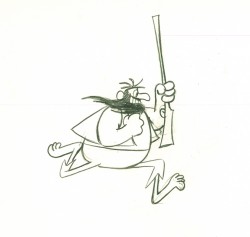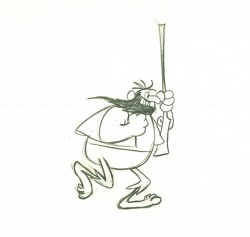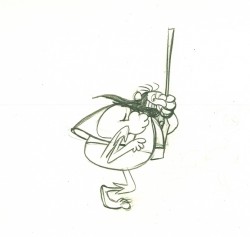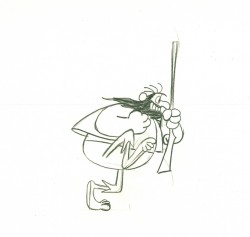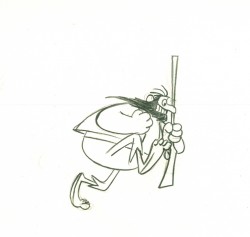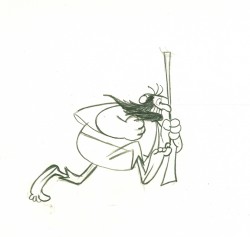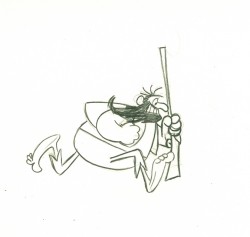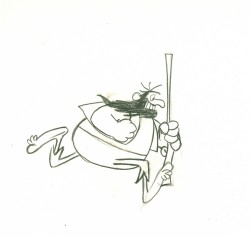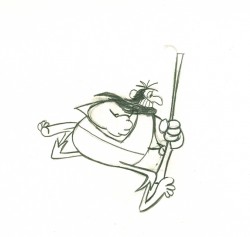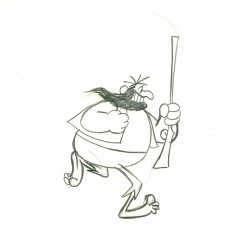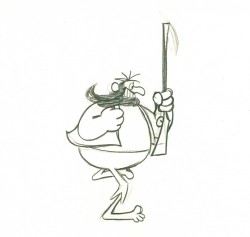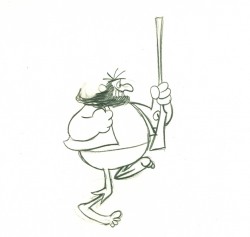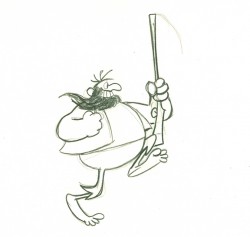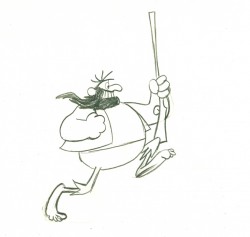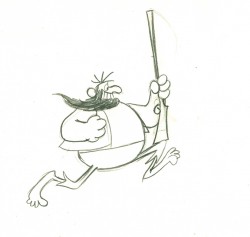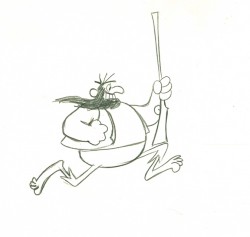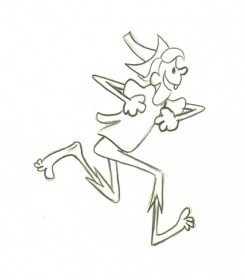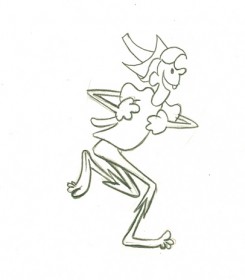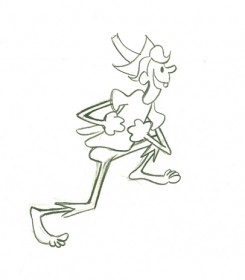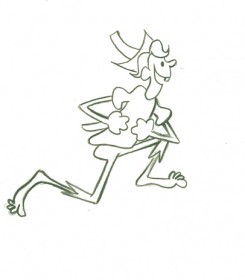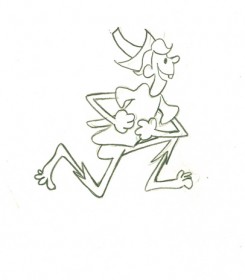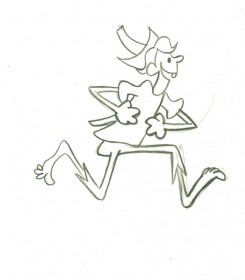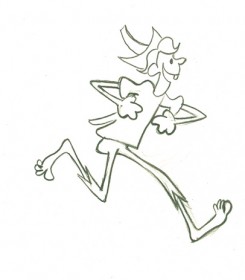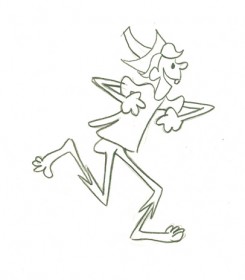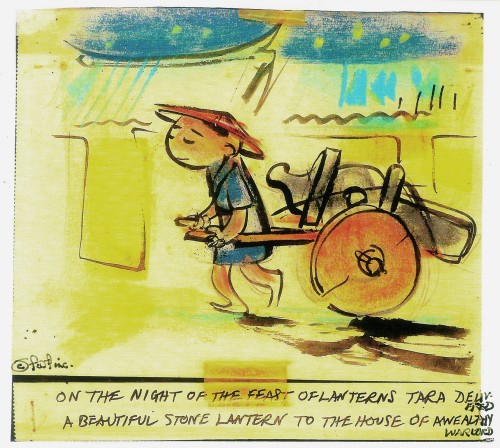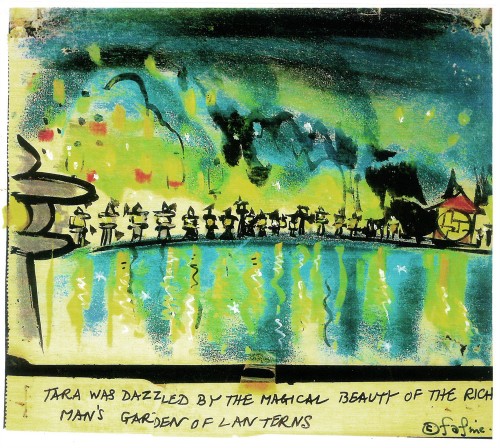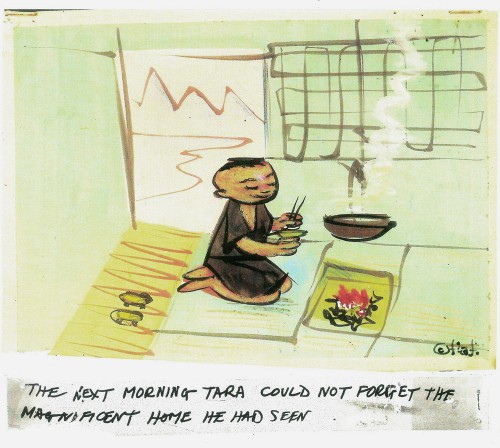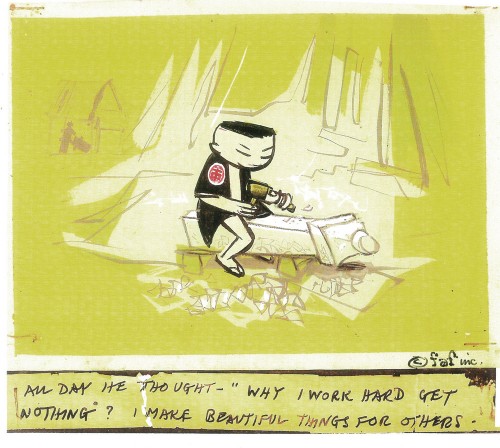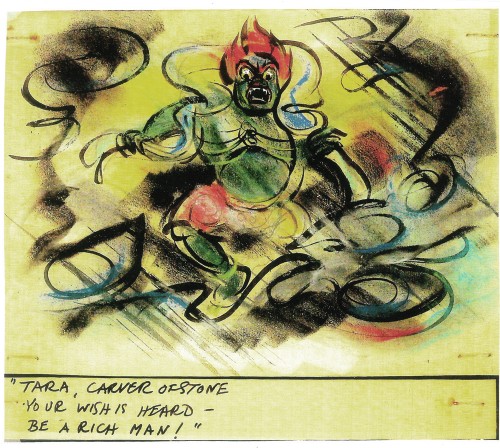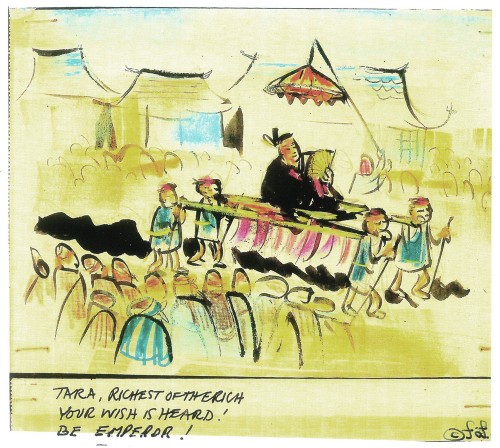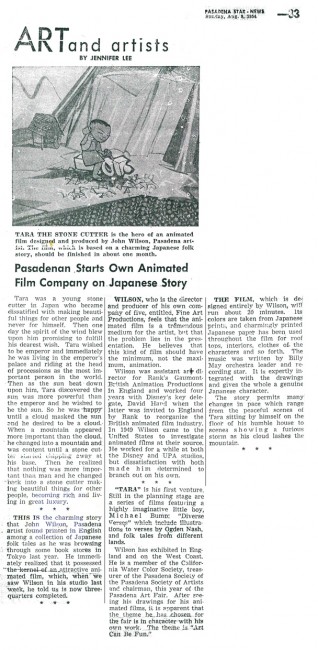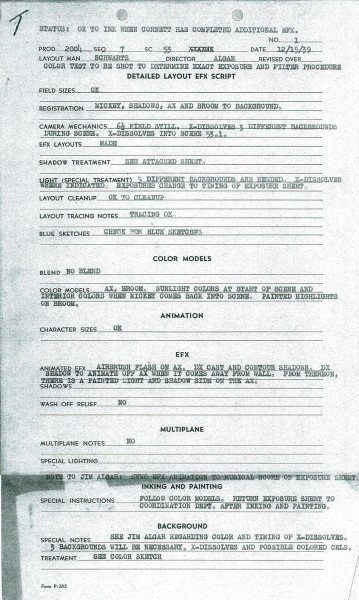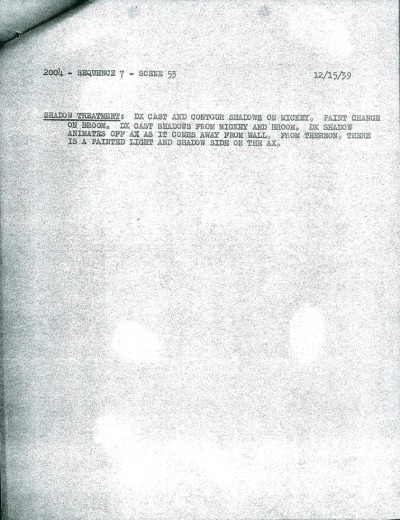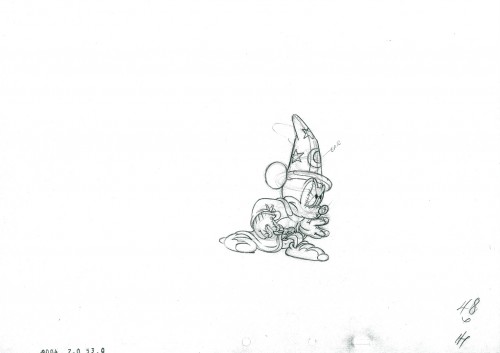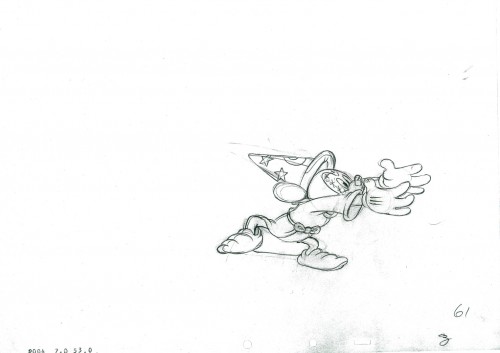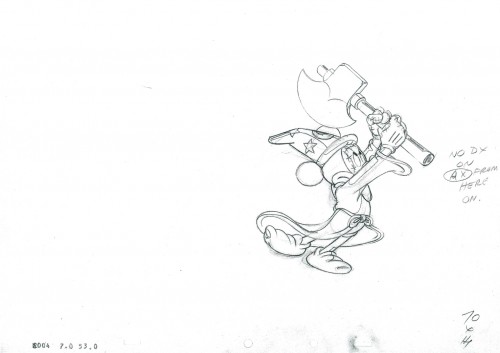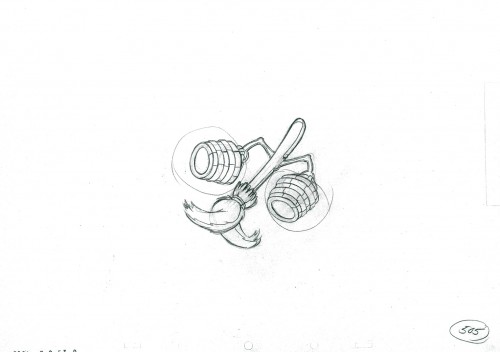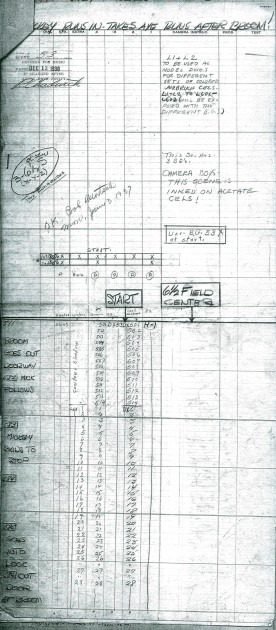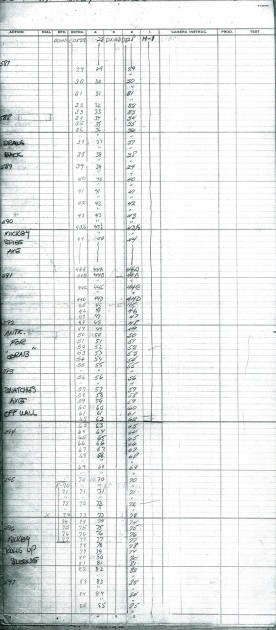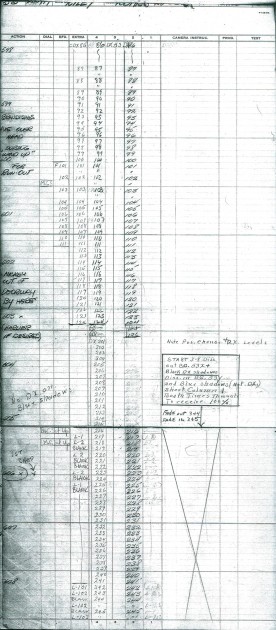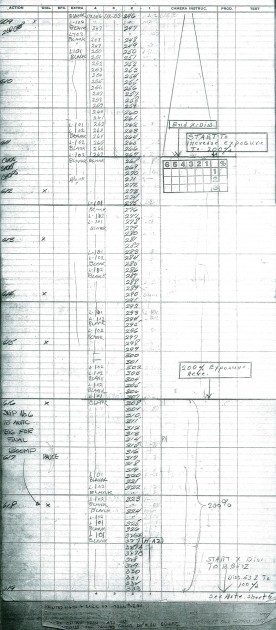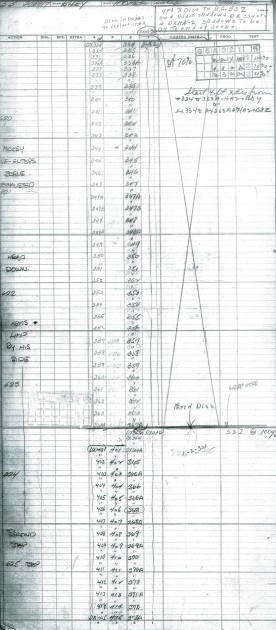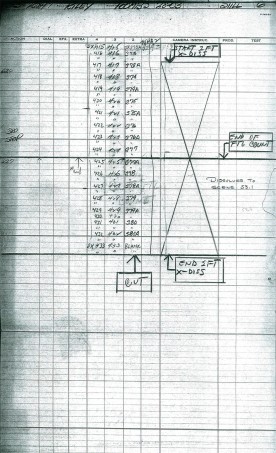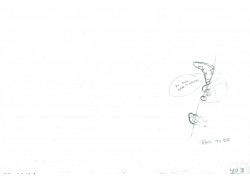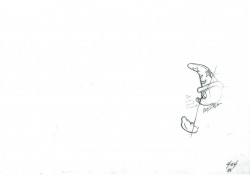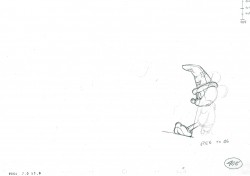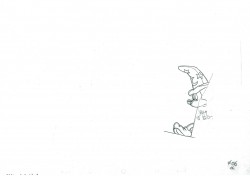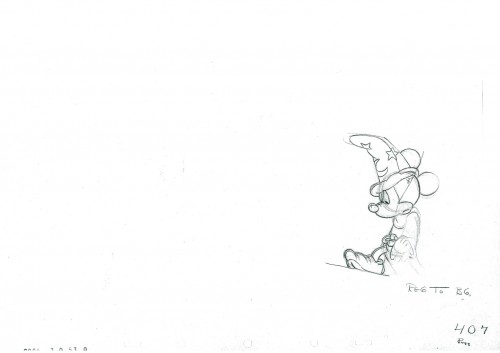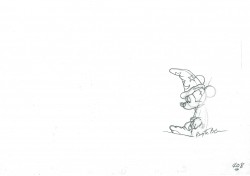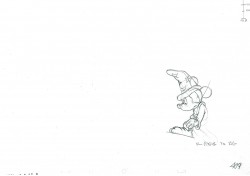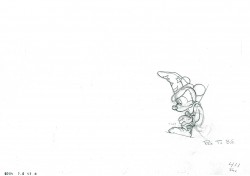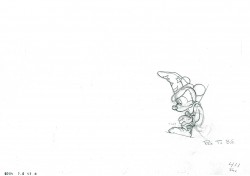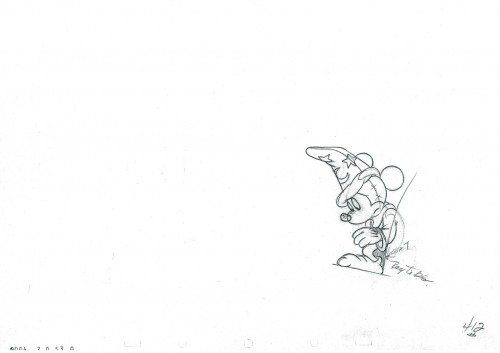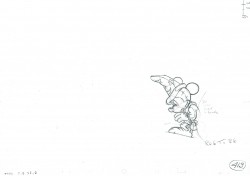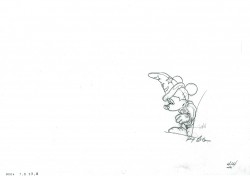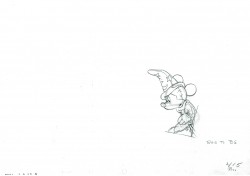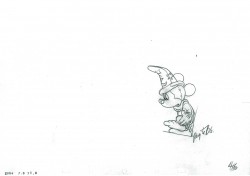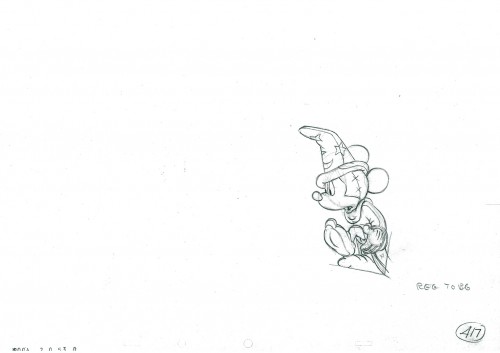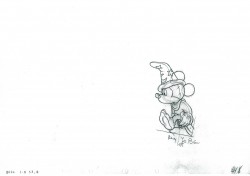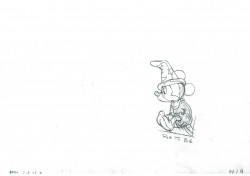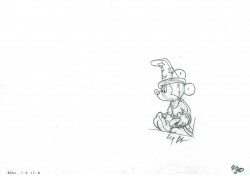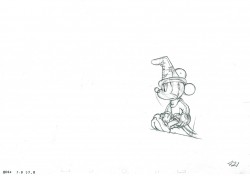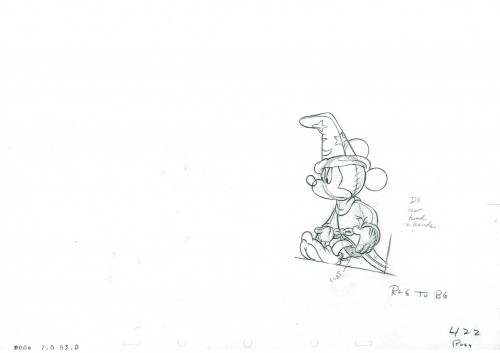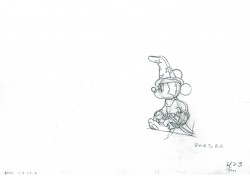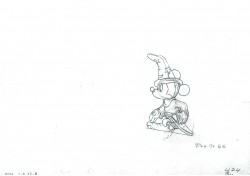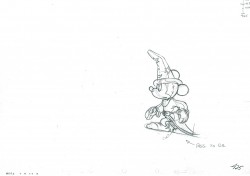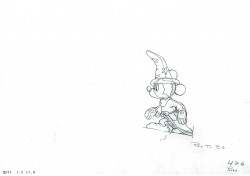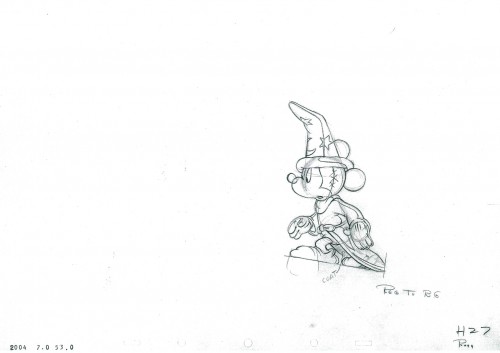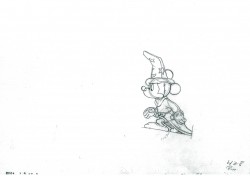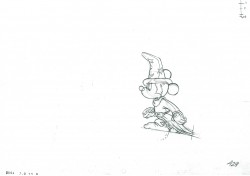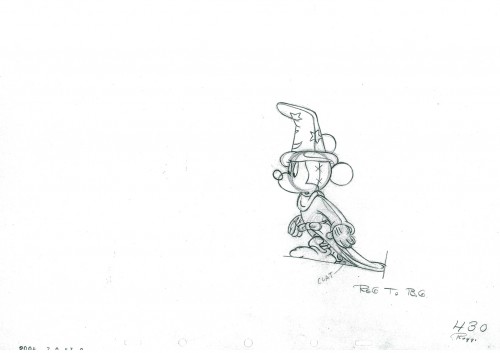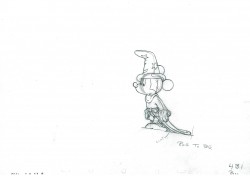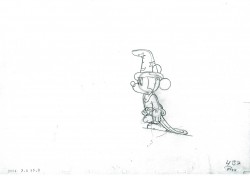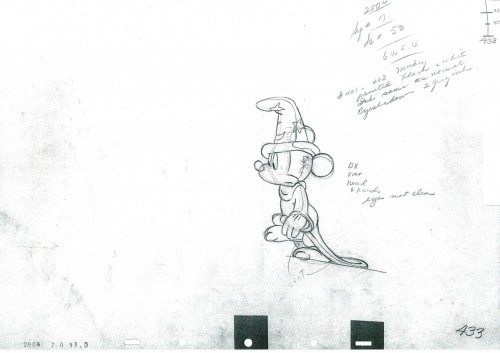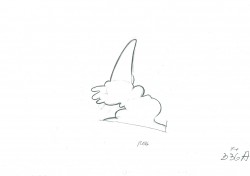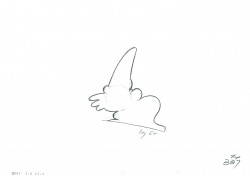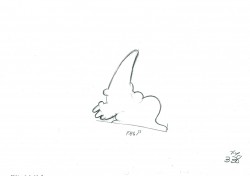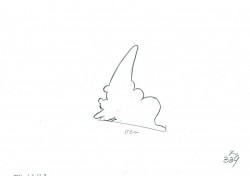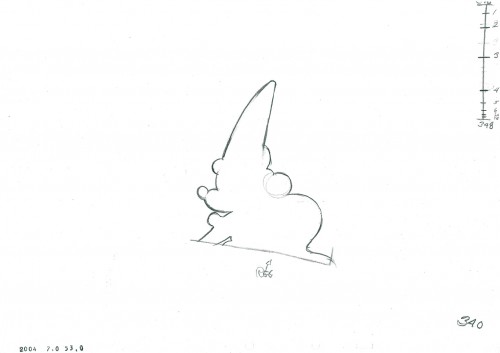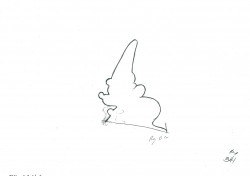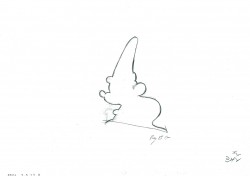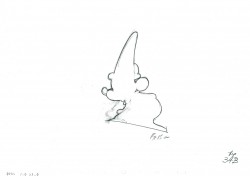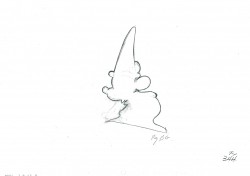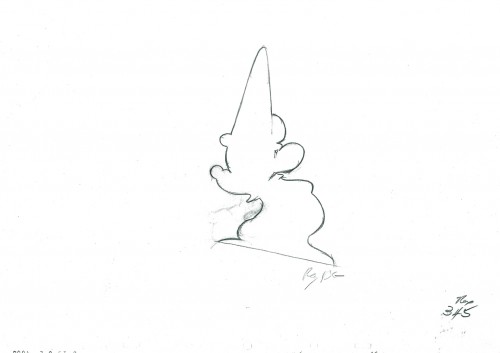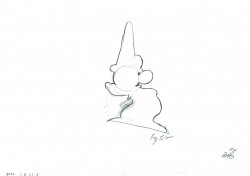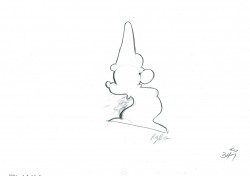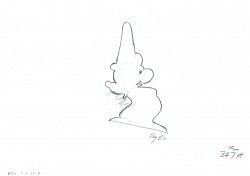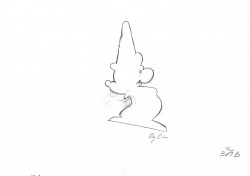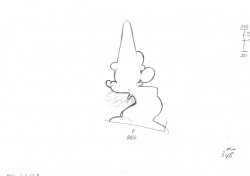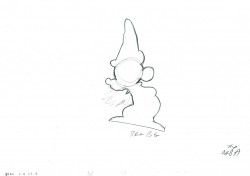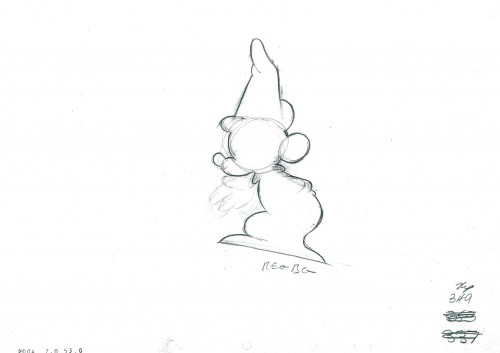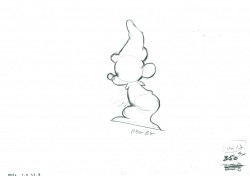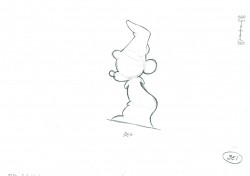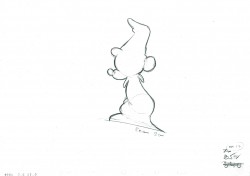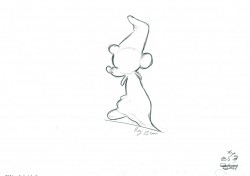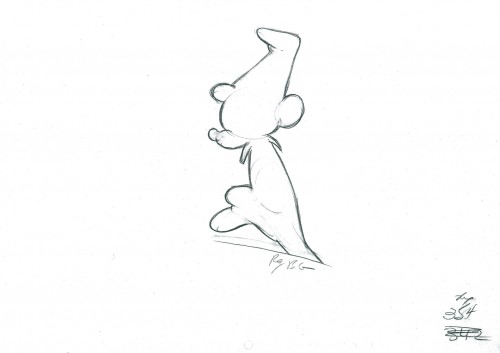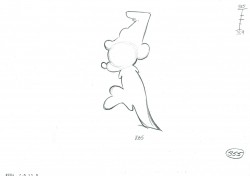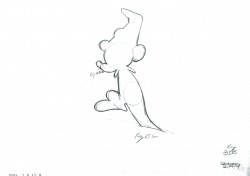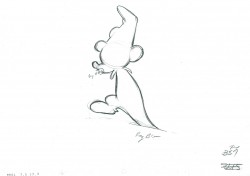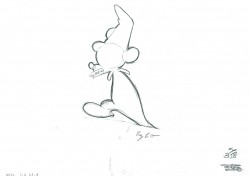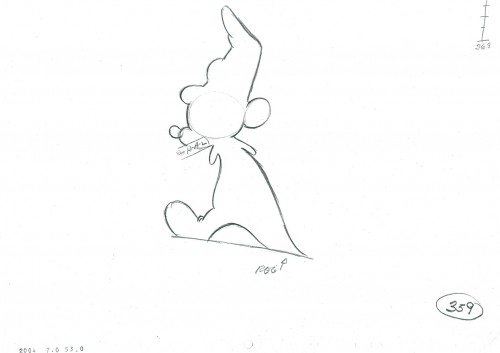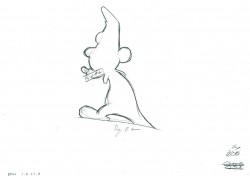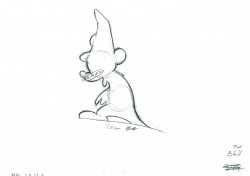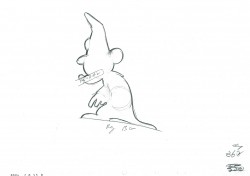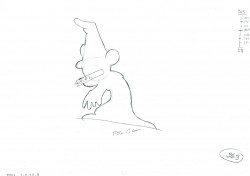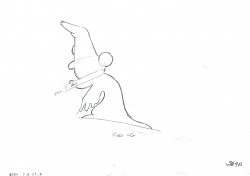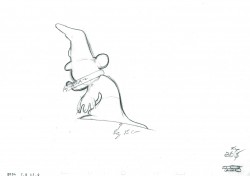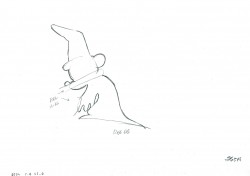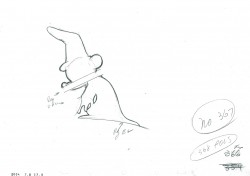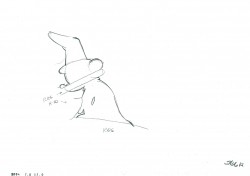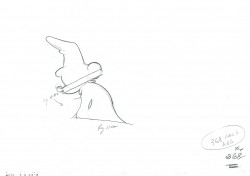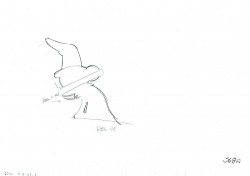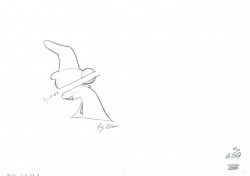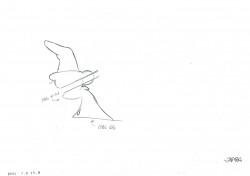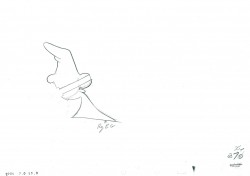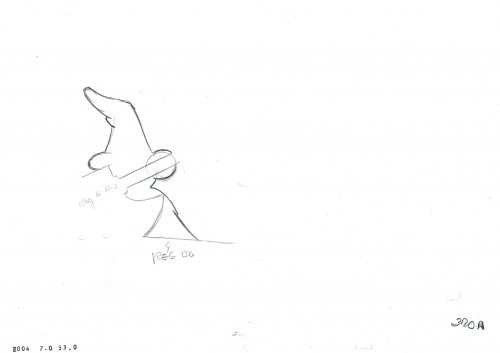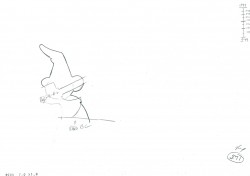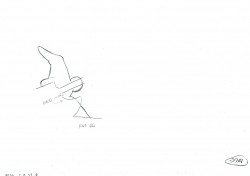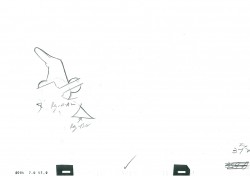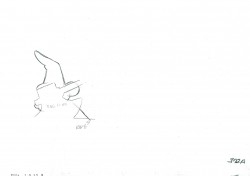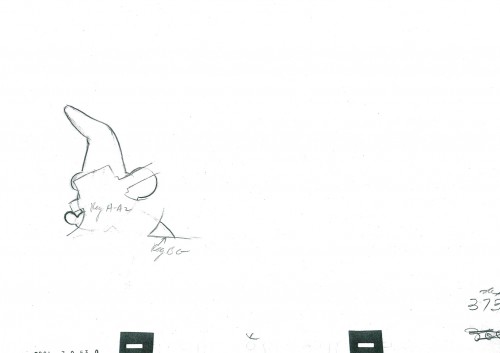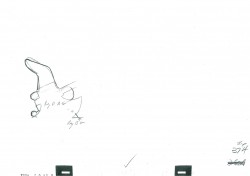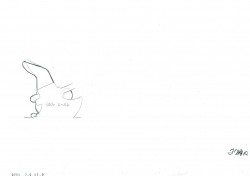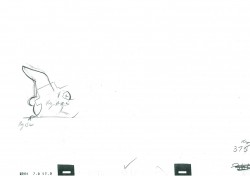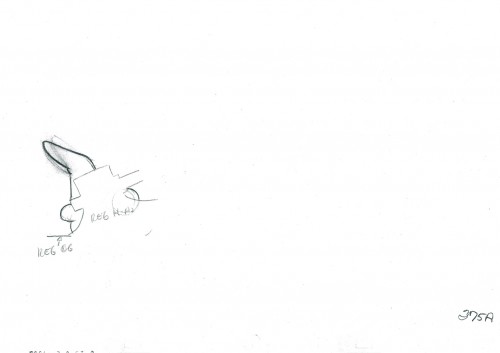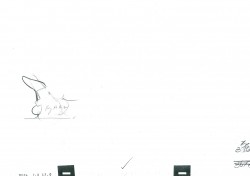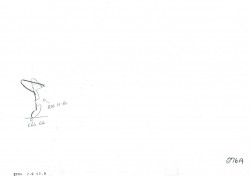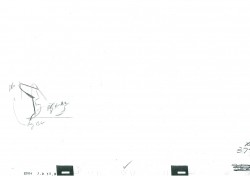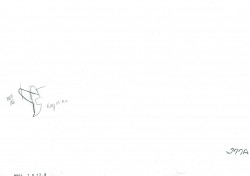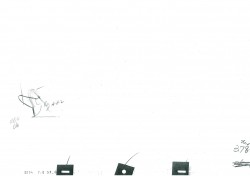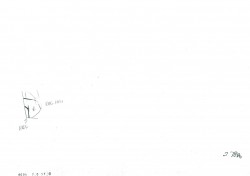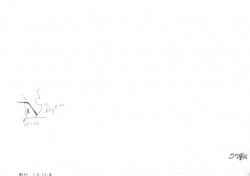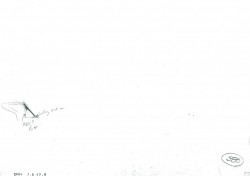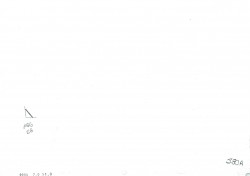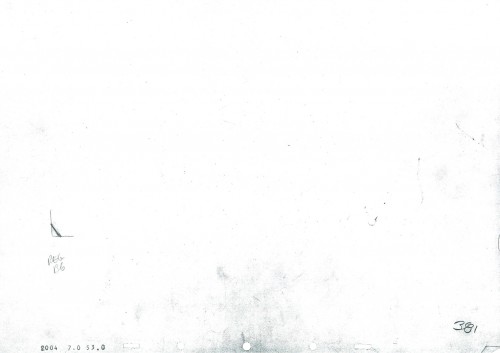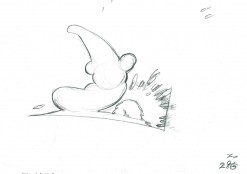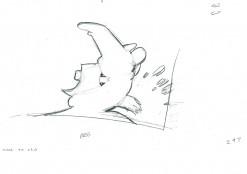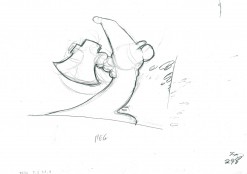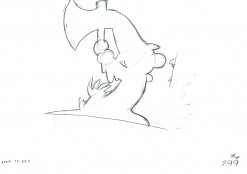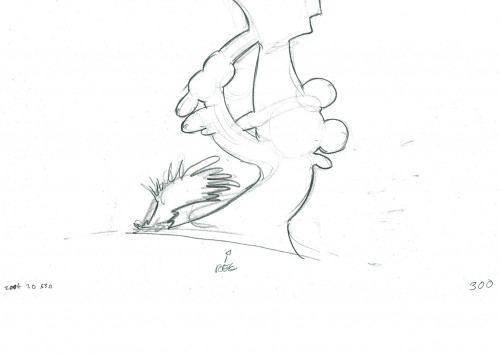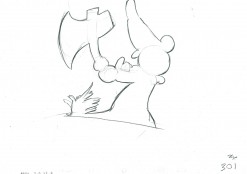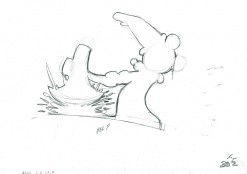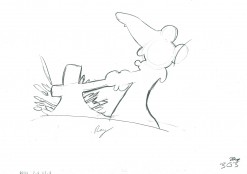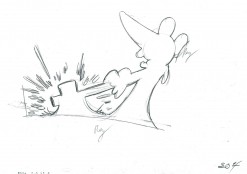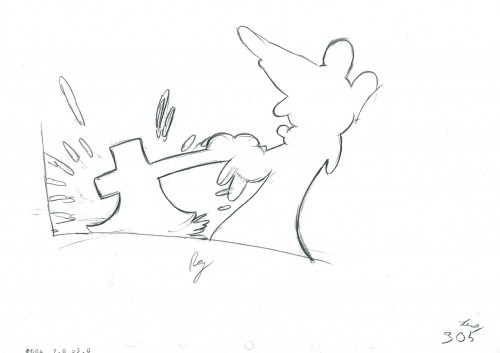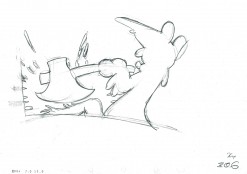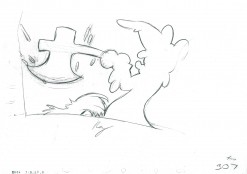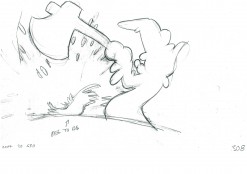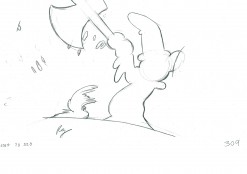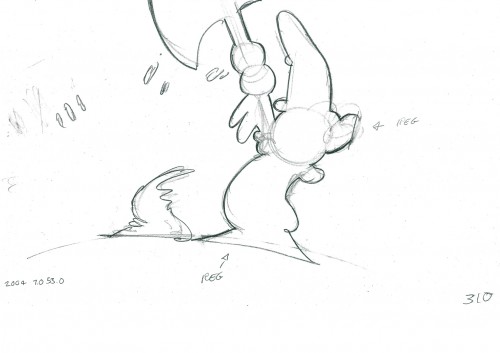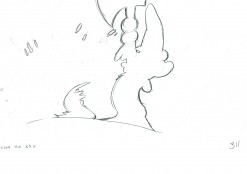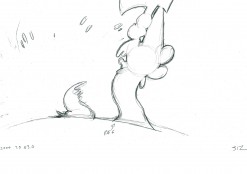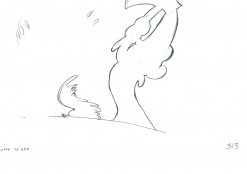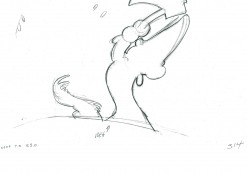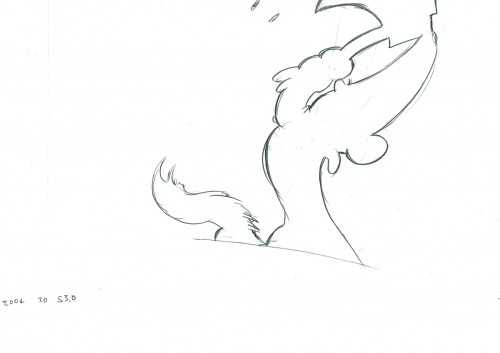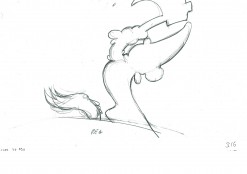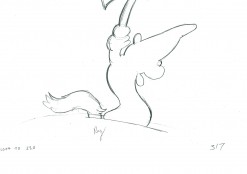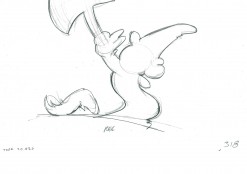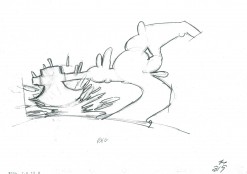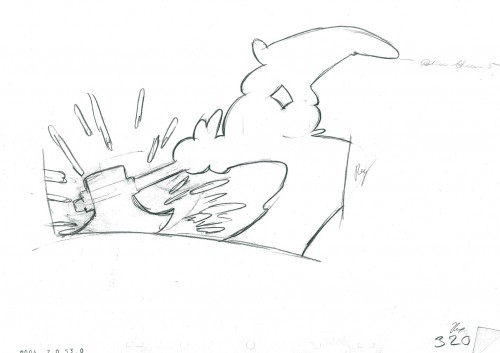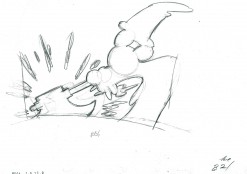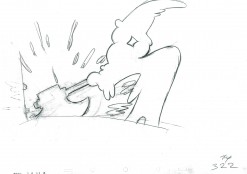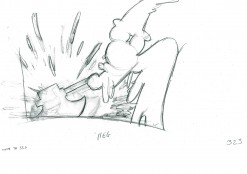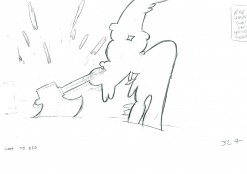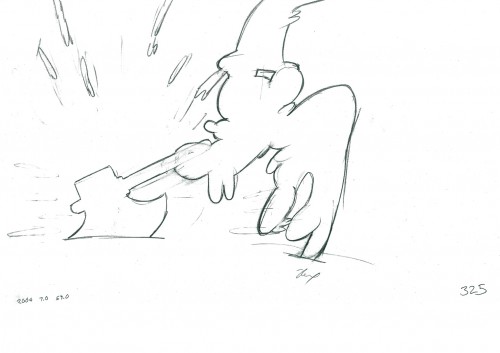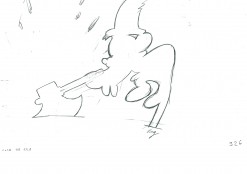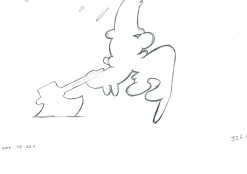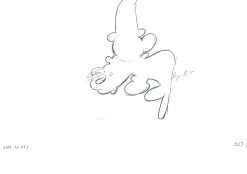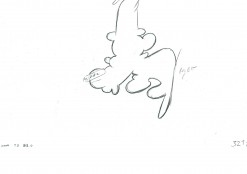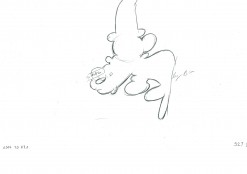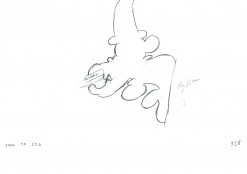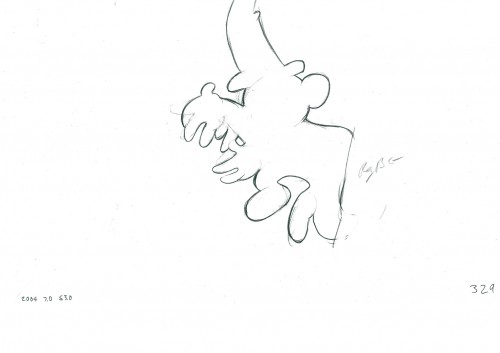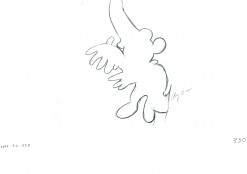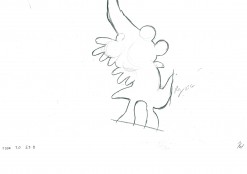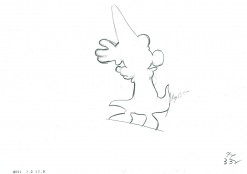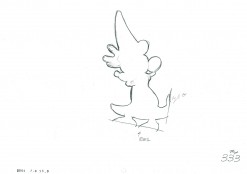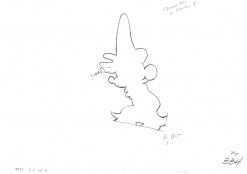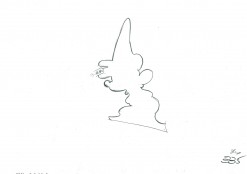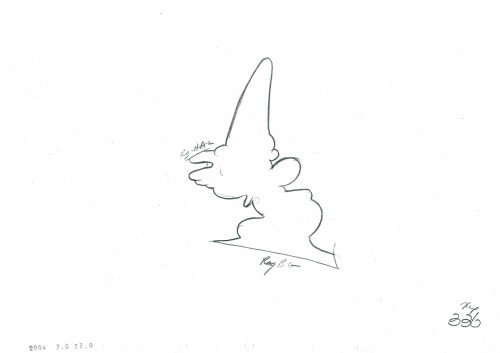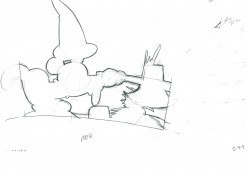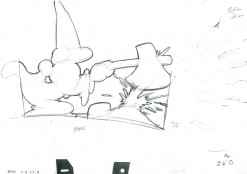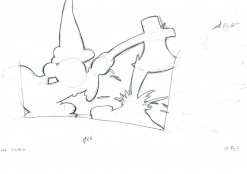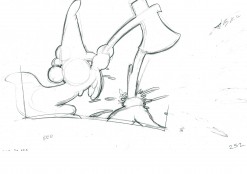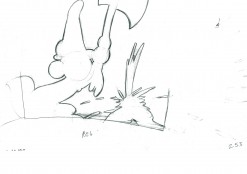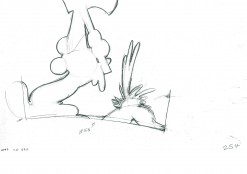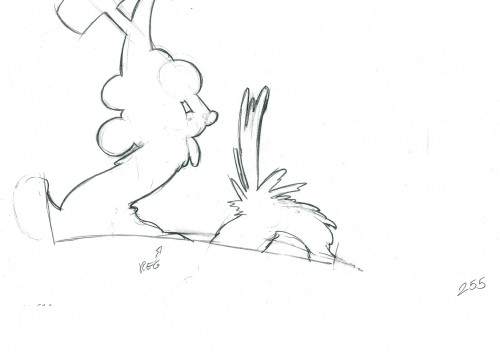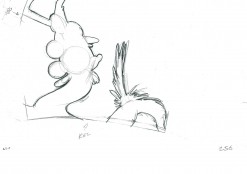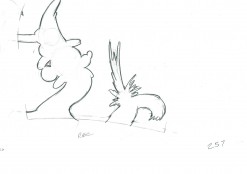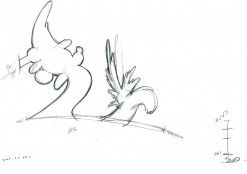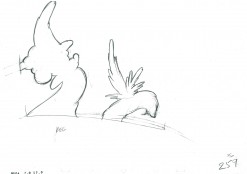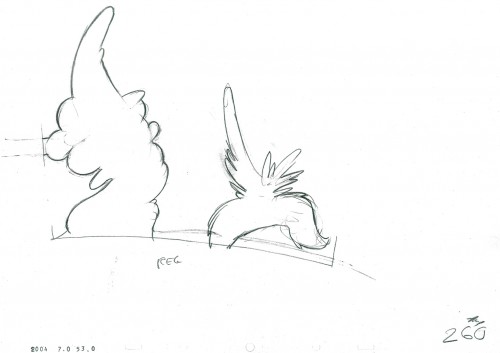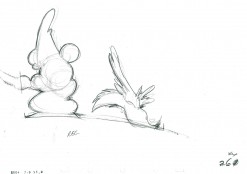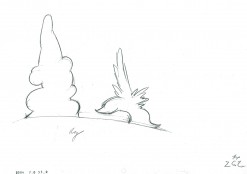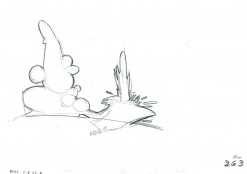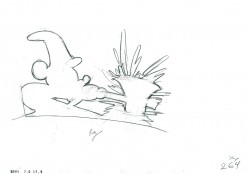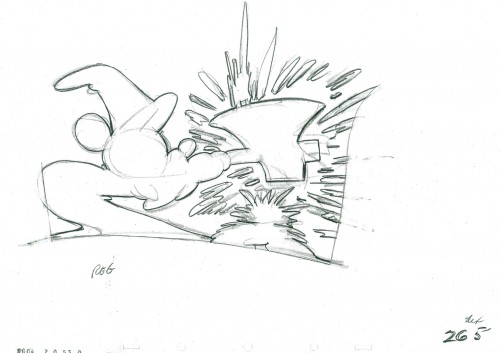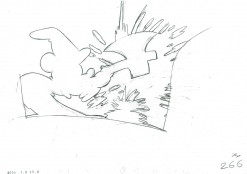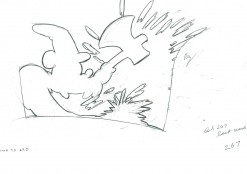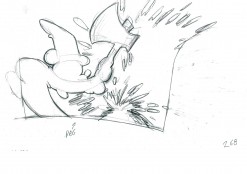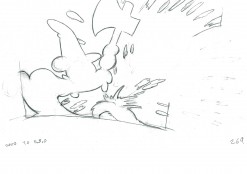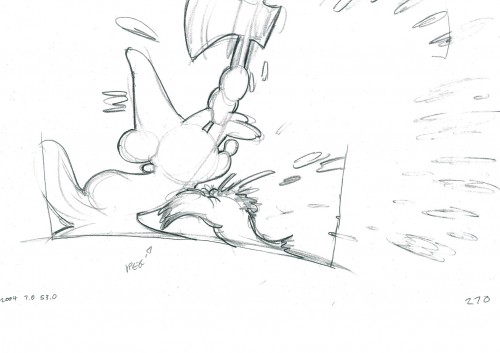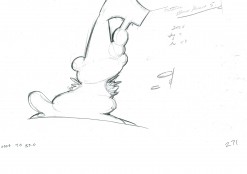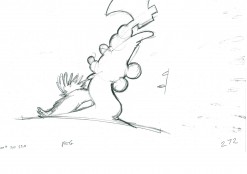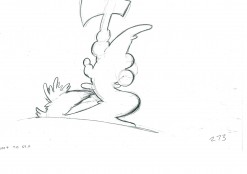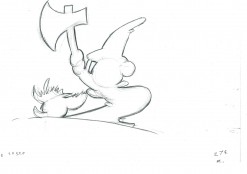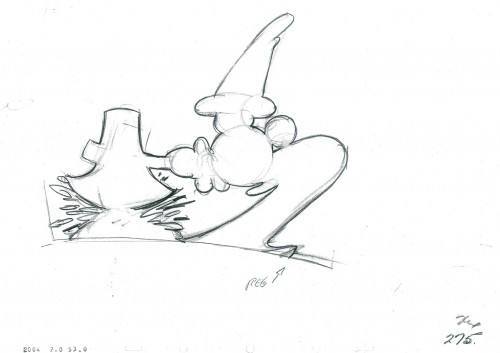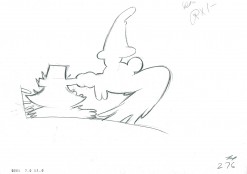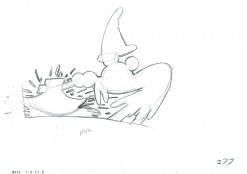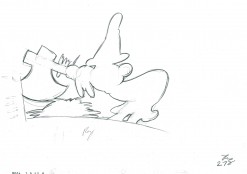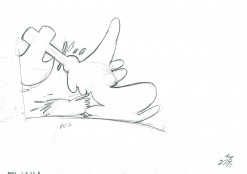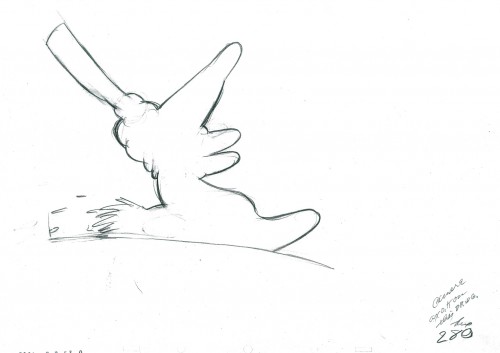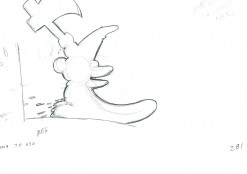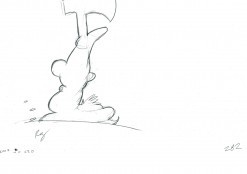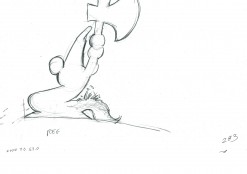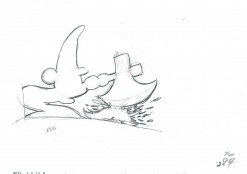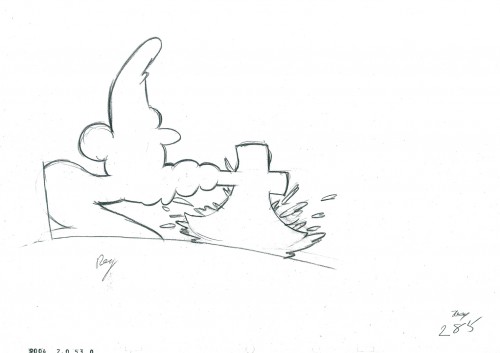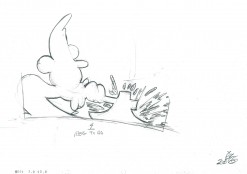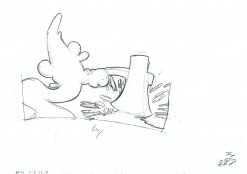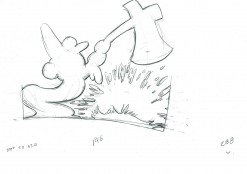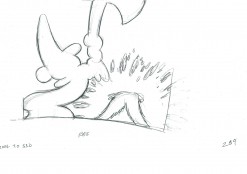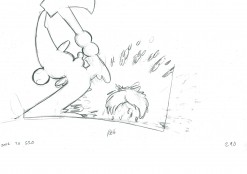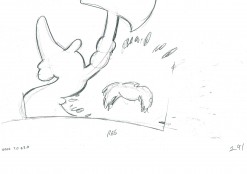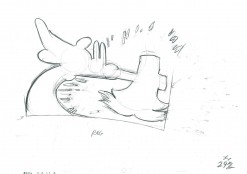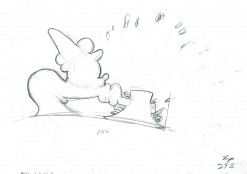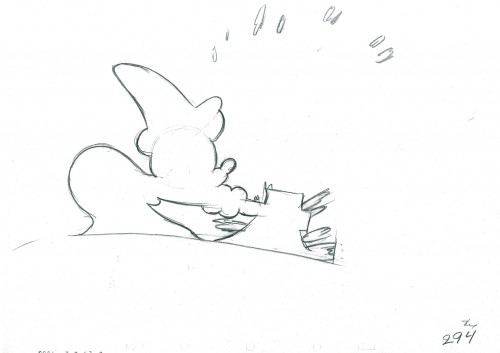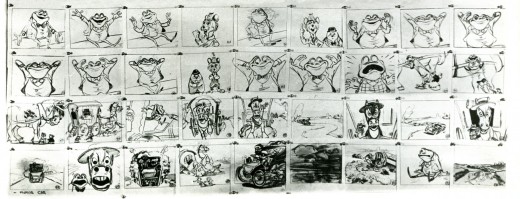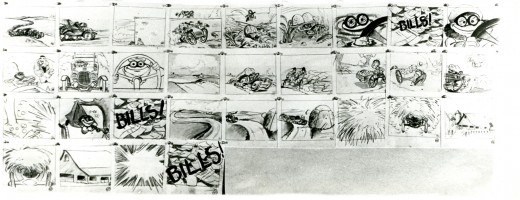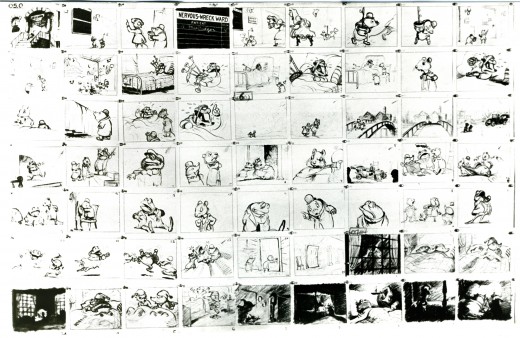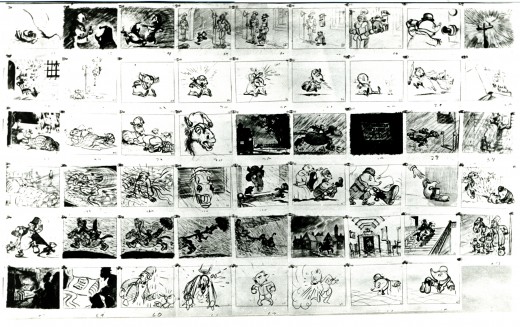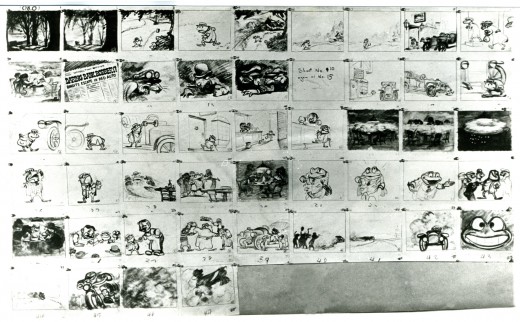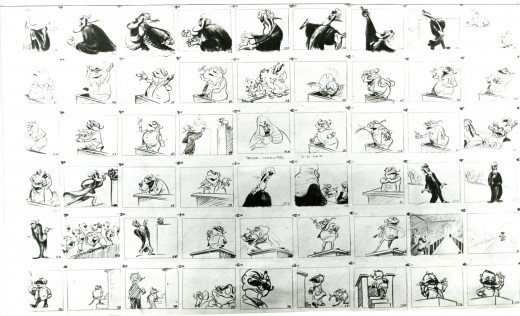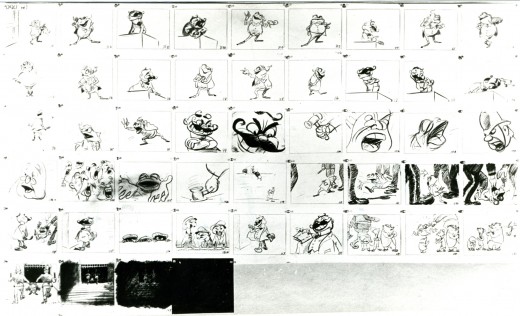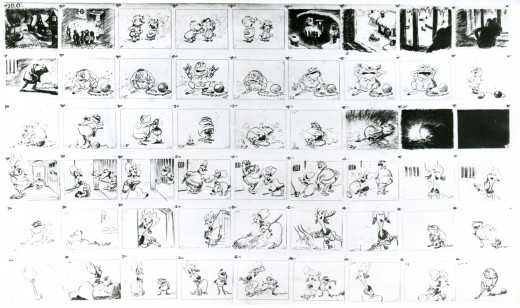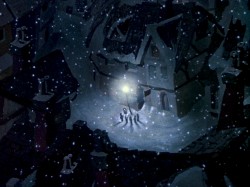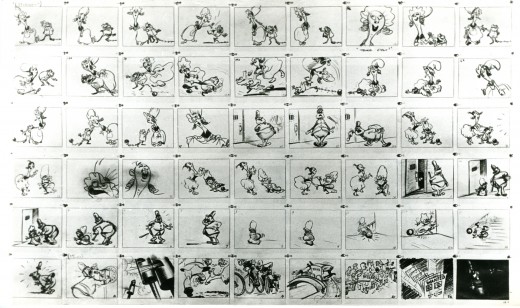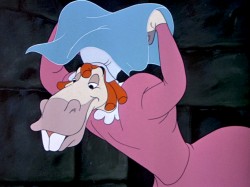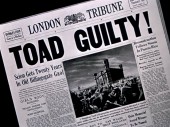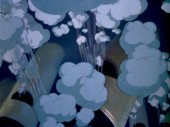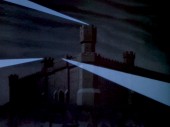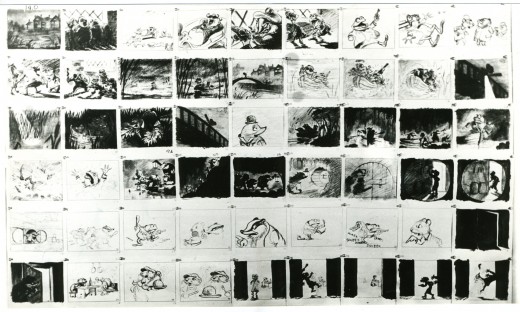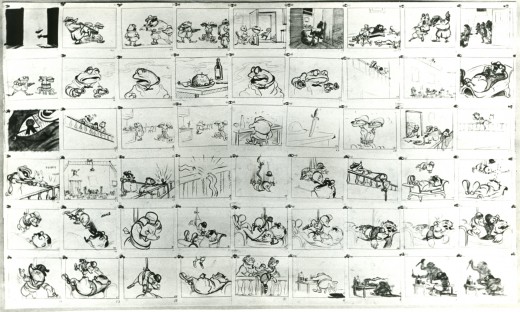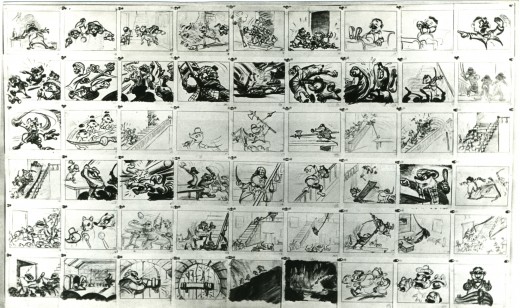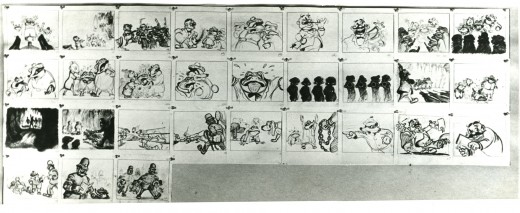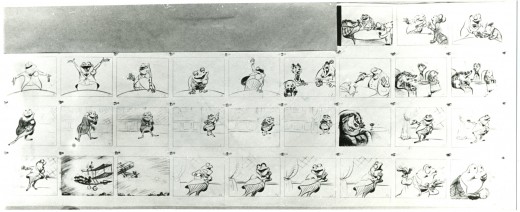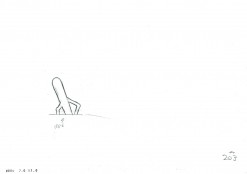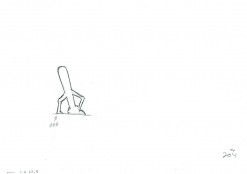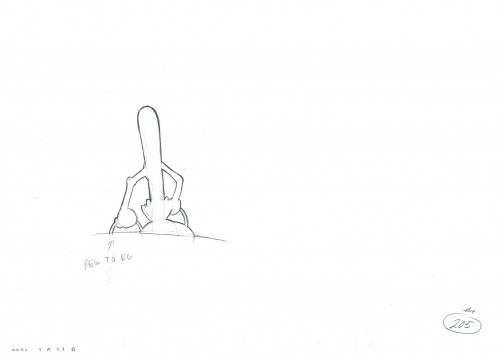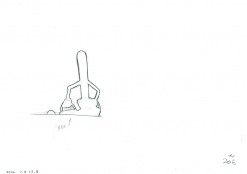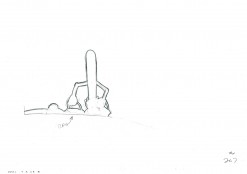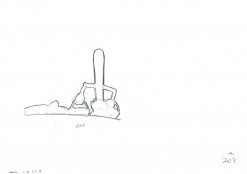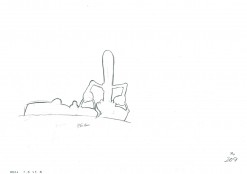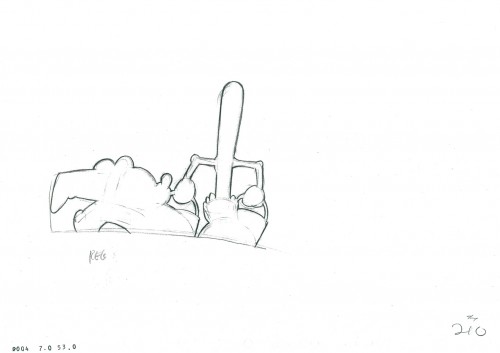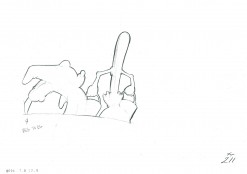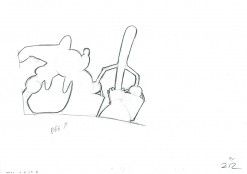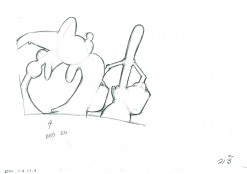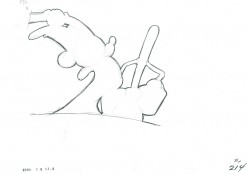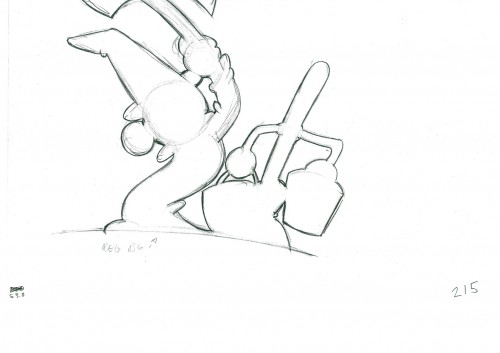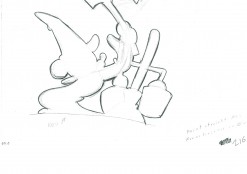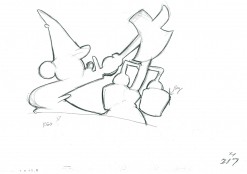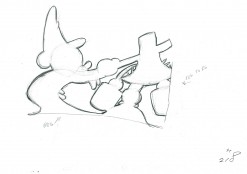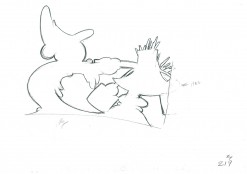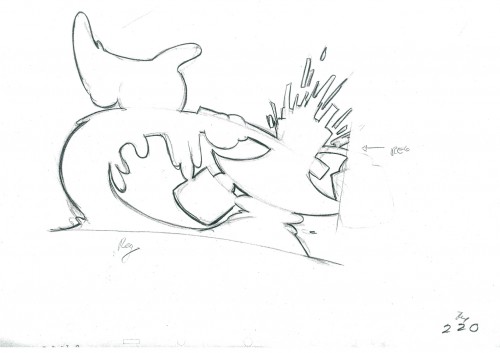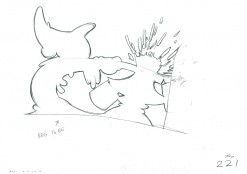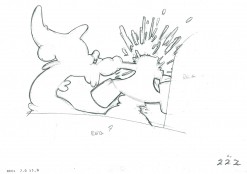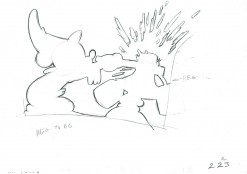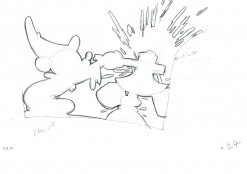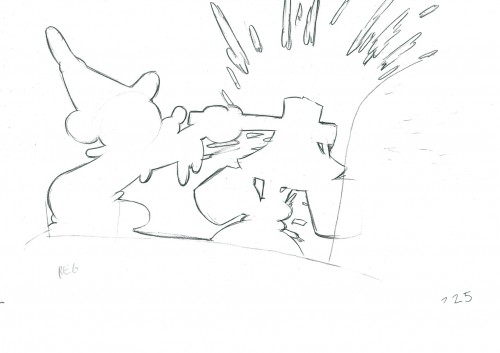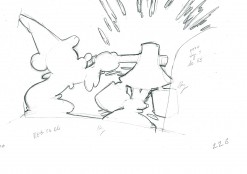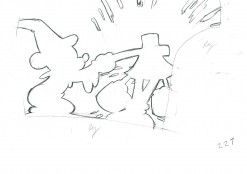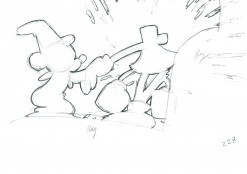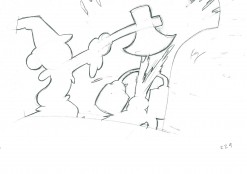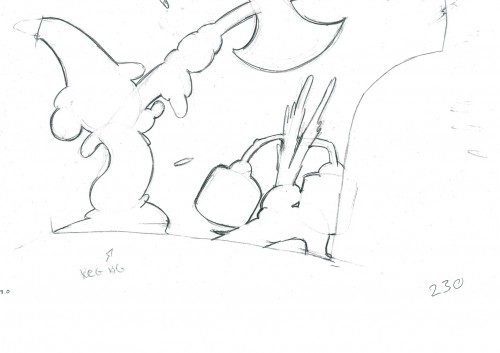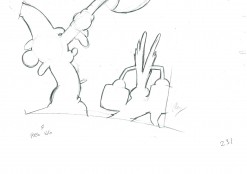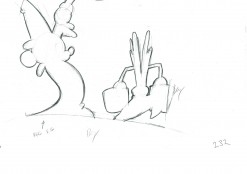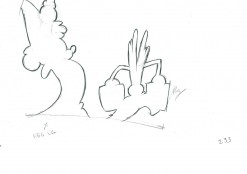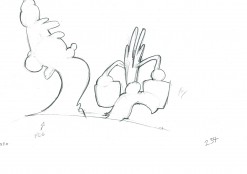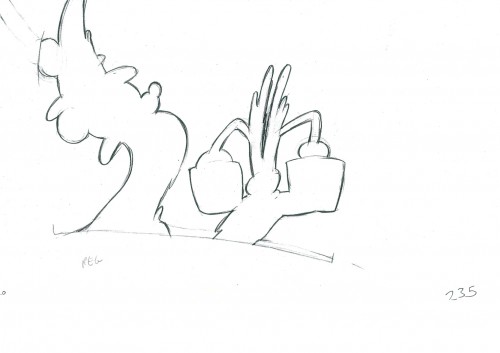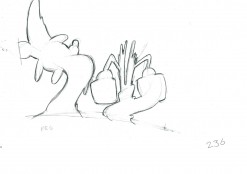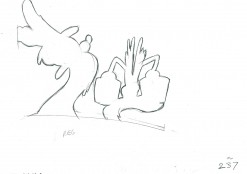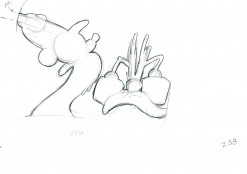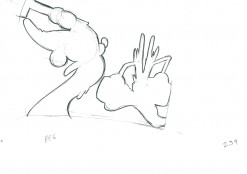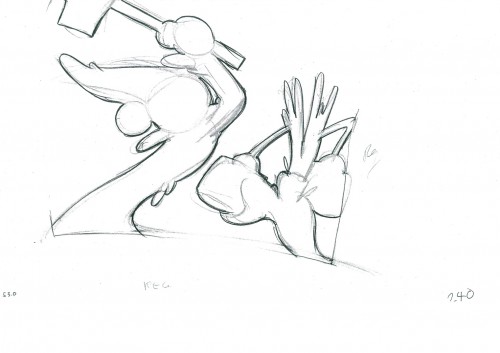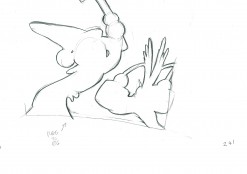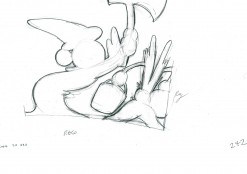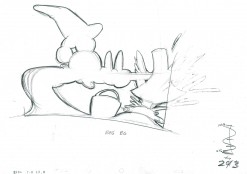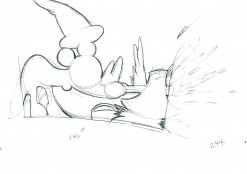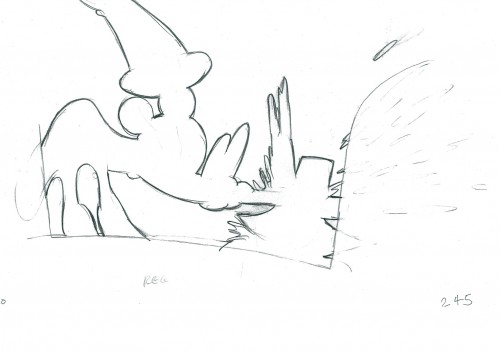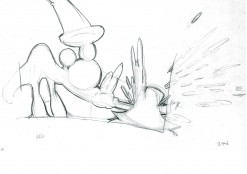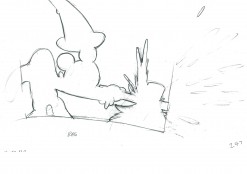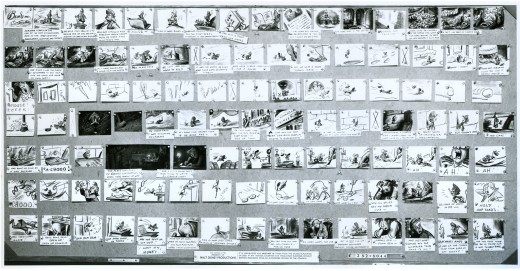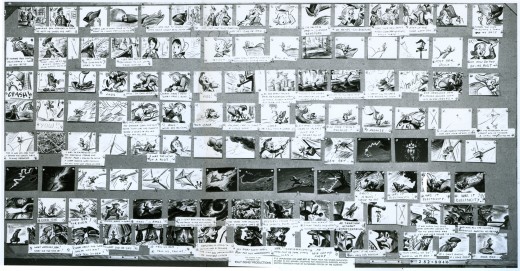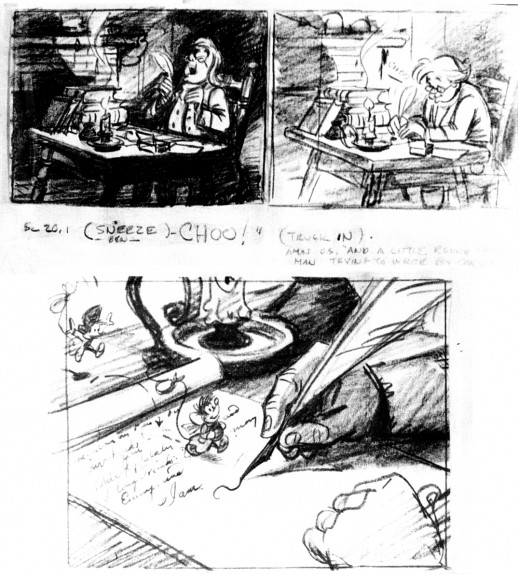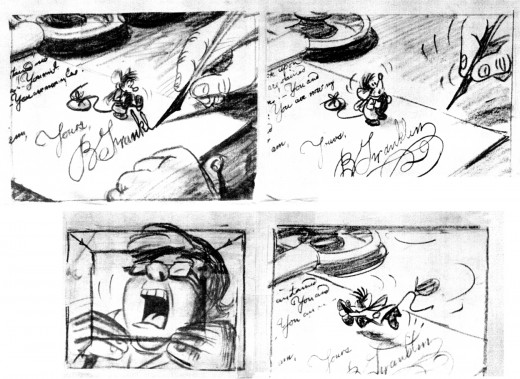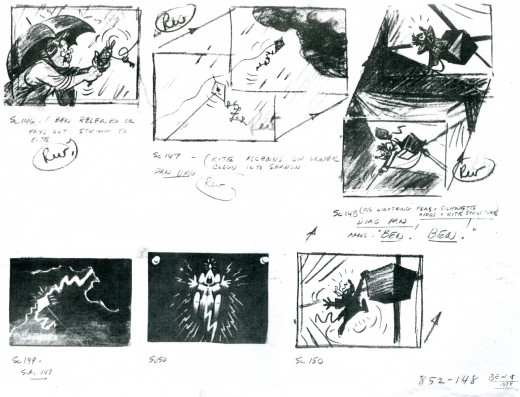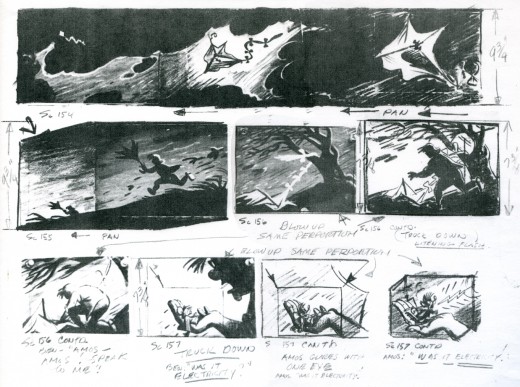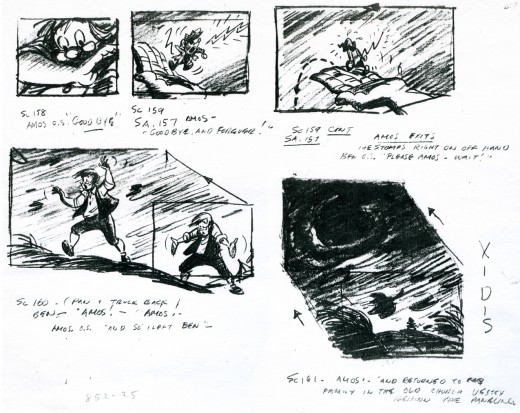Category ArchiveAnimation Artifacts
Animation &Animation Artifacts &repeated posts &Tissa David 11 Jan 2012 06:03 am
Hillbilly Run Cycles – Grim Natwick/Tissa David
- When I first started in animation at the Hubley Studio, I met Tissa David. She recognized how poor my inbetweens were and took me under her wing to try to correct the situation. She gave me private lessons for years. Often she would give me scenes animated by her mentor, Grim Natwick, and she would ask me to remove every other drawing and do new inbetweens for what was left. When I finally got them close to being correct, she’d have me do clean-ups of Grim’s work.
These two run cycles were among the first drawings she gave me to rework. Back then, the only way to see the drawings in motion was to flip them or film them. There were no computers to see them instantaneously moving. You can just go to the bottom of each cycle, and I’ve added a QT pencil test,
I might suggest that if you’re just starting out, you should print out the drawings and then do new versions of the inbetweens for the even numbered drawings. Go back to Tissa’s versions to compare with what you did.
Grim Natwick animated this spot for Mountain Dew when he worked for Robert Lawrence Productions. Here are two run cycles from that spot. It was assisted by Tissa David. All of the drawings, here, are Tissa’s clean-ups.
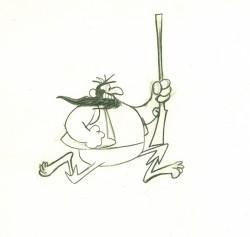 1
1 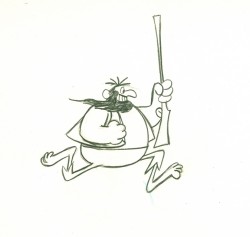 2
2
(Click any image to enlarge to full size.)
On ones at 24FPS
Click left side of bar to play.
Right side to watch single frame.
This is another run cycle from that same film. Again, all of the drawings, here, are Tissa’s clean-ups.
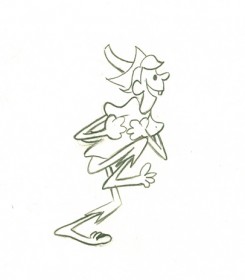 1
1 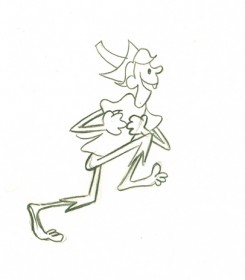 2
2
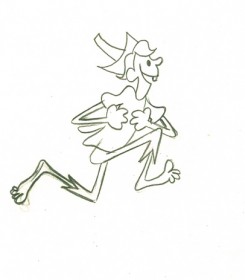 3
3 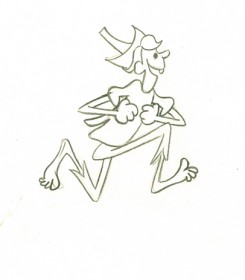 4
4
You’ll note that the character leaves the ground for 1/3 of the spot.
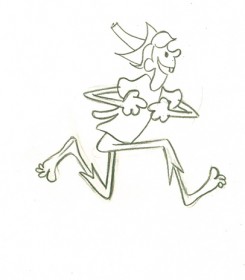 5
5 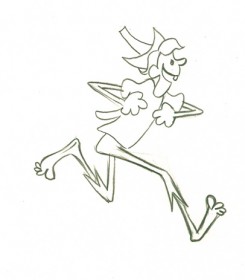 6
6
I love the chicken movement this guy is doing with his arms.
A laugh riot of a run cycle.
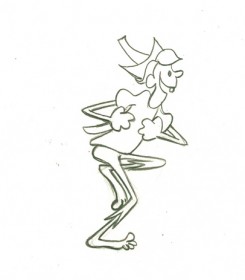 9
9 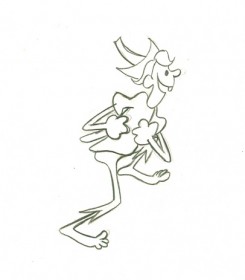 10
10
He actually comes down in the crossing position rather than the
classically designed walk where the head moves up.
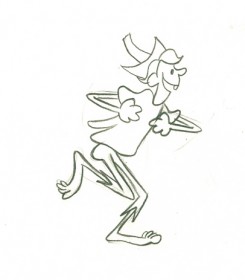 17
17 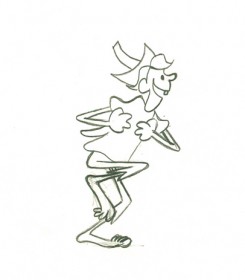 18
18
Tissa’s tendency is to have the crossing position the lowest in the cycle.
The character bears the weight of his walk with feet solidly on ground.
On ones at 24FPS
Click left side of black bar to play.
Right side to watch single frame.
This was originally posted in May 2009.
Animation Artifacts &commercial animation &Independent Animation 09 Jan 2012 06:18 am
John Wilson/Fine Art Films – part 1
- For the next three weeks, I’m going to focus on director/designer/animator, John Wilson.
Amid Amidi presented me with some art that he thought might be a good match for this blog, and it is. So I’ll take advantage of the material and share it with you. With each week’s post I’ll hone in on one specific film and go from there. We’ll start with Wilson’s first solo film, Tara the Stone Cutter completed in 1955.
But first, let me share some bio information about John Wilson and his company Fine Arts Films.
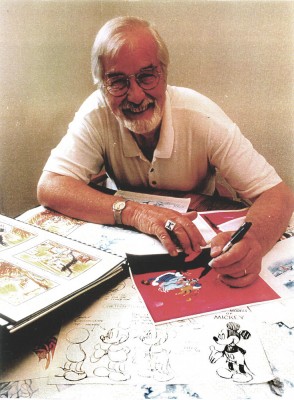 - John Wilson was born in Wimbledon in 1920. He attended the Royal College of Art and was working by age 18 as a commercial artist with Willings Press Service. In WWII he served with the London Rifle Brigade in African where he was seriously wounded. Recuperating in hospital, he drew many cartoons of which several were printed. Eventually he would recover and get work at Pinewood Studios in the art department where he worked on GREAT EXPECTATIONS and THE THIEF OF BAGHDAD, among other films.
- John Wilson was born in Wimbledon in 1920. He attended the Royal College of Art and was working by age 18 as a commercial artist with Willings Press Service. In WWII he served with the London Rifle Brigade in African where he was seriously wounded. Recuperating in hospital, he drew many cartoons of which several were printed. Eventually he would recover and get work at Pinewood Studios in the art department where he worked on GREAT EXPECTATIONS and THE THIEF OF BAGHDAD, among other films.- By the time he was 25, he was working in animation at Gaumont-British Animation, a newly formed division of J. Arthur Rank’s studio, working under the direction of David Hand on the “Animaland” series starring “Ginger Nut.”
- In 1950 he moved to the United States working in layout and animation at UPA. He found himself working with Bobe Cannon, Pete Burness, Jules Engel, and Paul Julian. Eventually he left for the Disney studio working in Les Clark’s ‘Tinkerbell’ unit on PETER PAN and with Ward Kimball on TOOT WHISTLE PLUNK & BOOM.
- He tried to sell Disney on the film Tara, the Stonecutter, but they weren’t interested. He completed it himself in 1955 using a Japanese style to tell the story. Wilson was impressed with the UPA style of modern art in animation, and that’s the route he took for his personal film. Thus his studio was born, called Fine Arts Films, in 1955. Tara had some success playing theatrically with the successful Japanese feature film, GATE OF HELL by Kinugasa (which had won the Oscar for Best Foreign Film.)
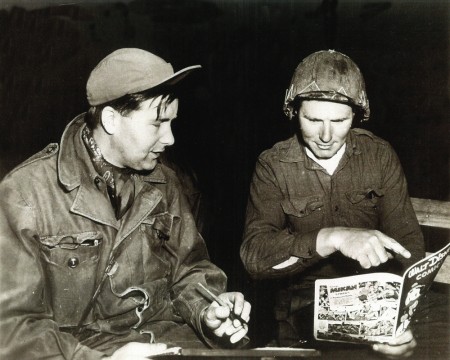
Wilson in Korea with the Bob Hope Tour to entertain the troops.
- This film led to his producing a verion of Stravinsky’s Petroushka for NBC which aired in 1956 as part of The Sol Hurok Music Hour. Notably, Stravinsky, himself, arranged and conducted the shortened version of the score suing the LA Philharmonic Orchestra. The film was designed by John Wilson and Dean Spille with anmation by Bill Littlejohn, Art Davis, and Phil Monroe. Chris Jenkyns, Dean Spille and Ed DeMattia designed the 16 minute show from Wilson’s storyboard.
- Fine Arts Films had produced ‘Journey to the Stars’, a project for the 1961 World’s Fair, an animated voyage through space for NASA, which was seen in 70 mm Cinerama by ten million visitors to Seattle.
- Billy Wilder employed Wilson to do the titles for Irma La Douce after which they did a six-minute trailer for this Jack Lemmon, Shirley McLaine feature. It was all about Parisian prostitutes romping about in Montmartre, and animation could apparently make it acceptable. Artists Ron Maidenberg, Sam Weiss, Sam Cornell and Bob Curtis caught the vivid nightlife of Paris in a sexually charged animated short. It was a huge success in promoting the feature.
- In 1970 Wilson flew to Chicago to see Carol Channing and Eddie Bracken appearing in “archy and mehitabel in Shinbone Alleyâ€. On the basis of this theatrical musical, Wilson bought the screen rights to the book “archy and mehitabel” by George Herriman and began work on an animated feature which was released by Allied Artists in 1971.
- Fine Arts Films was also responsible for many animated commercials as well as weekly music video segments for the weekly CBS-TV series “The Sonny and Cher Show.†The songs included Joni Mitchell’s “Big Yellow Taxi†and Jim Croce’s “Leroy Brown.â€
Here are some storyboard sketches by John Wilson for his initial short film, Tara, the Stonecutter. This film started it all for Wilson.
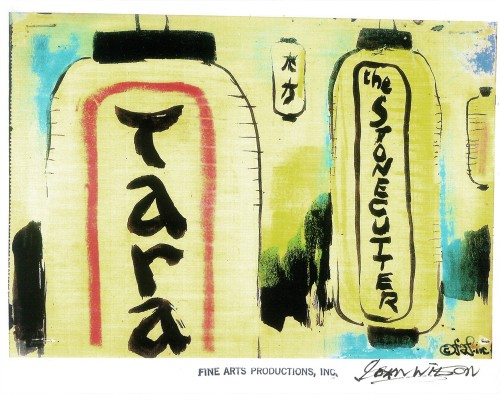 1
1
I haven’t seen the finished film, but I understand that Japanese decorative papers were used in the backgrounds and costumes of the characters.
Here are two press clippings for this film from California papers.
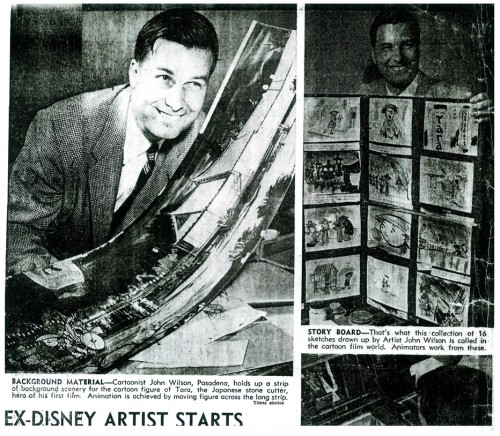
(Click any image to enlarge.)
Animation &Animation Artifacts &Disney 04 Jan 2012 07:20 am
Broom X Sheets
- This post is for real animator-type geeks. To complete the posting of the scene from Fantasia of Mickey chopping the broom, I have the exposure sheets as well as some notes and that I’d like to share. If you know how to read the sheets, it’ll be informative. If you don’t, take some time to try to understand them. Although there are some complications – several dissolves and indicated effx, specifically – much of it is basic.
These are all copies of copies, so the quality isn’t the greatest.
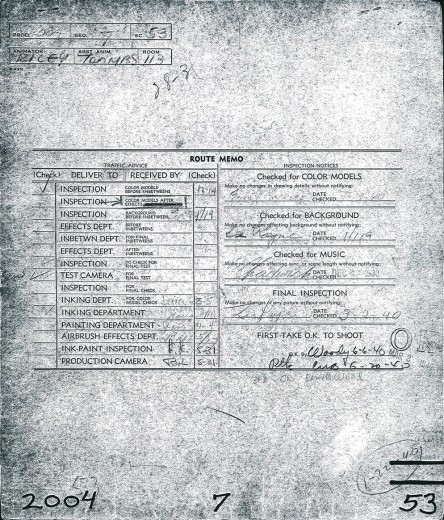
This is the cover of the folder for the scene.
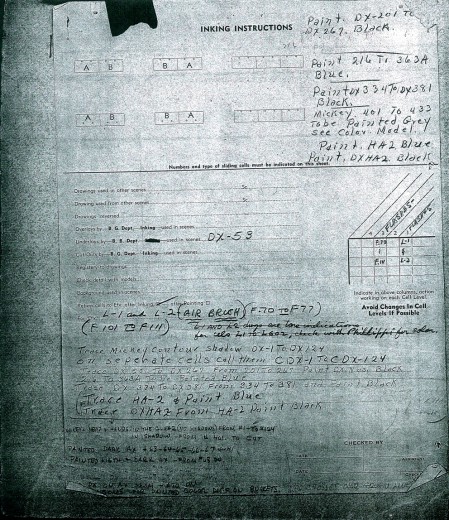
Inking instructions within the folder.
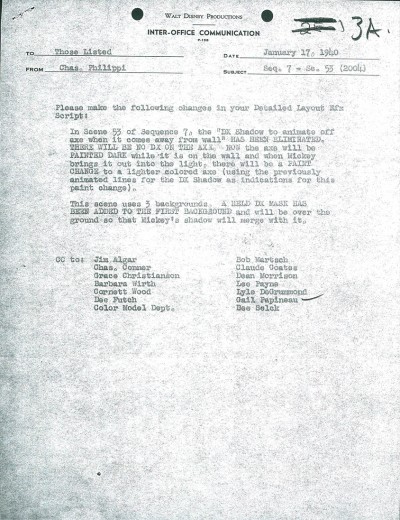
An interoffice communication about the scene.
The following are four samples of effx shading that was done
for all of Mickey and the brooms throughout the scene.
I show the original drawings followed by the effx drawing.
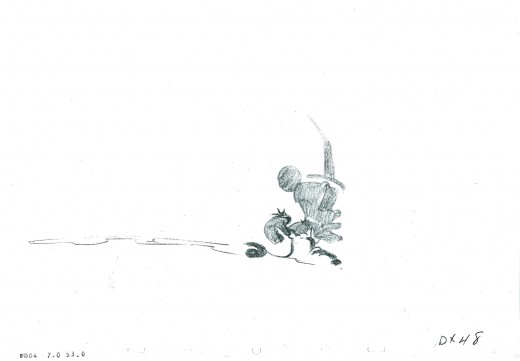
All of the effx drawings were done with a very light hand.
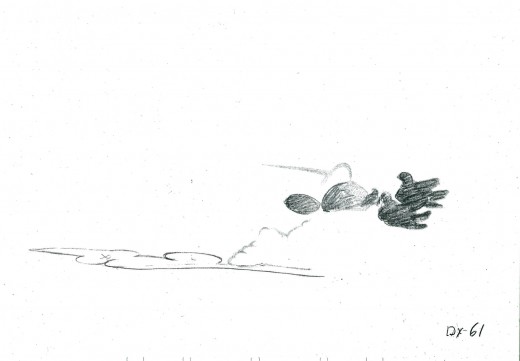
I had to push them like crazy in Photoshop so that you could see them here.
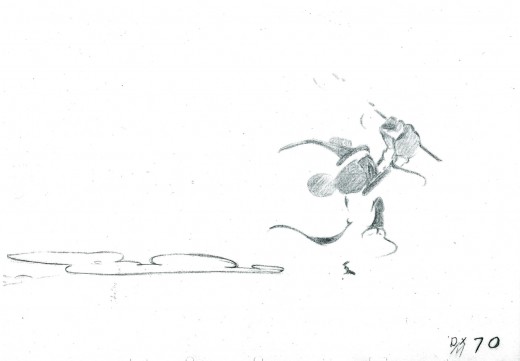
All of the Mickey & broom drawings were done this way as an
indication to the airbrush artists who would follow up.
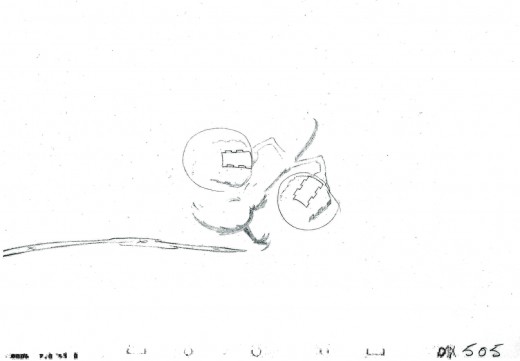
You’ll note that the scene was about to be reshot for the airbrushing.
The Exposure Sheets
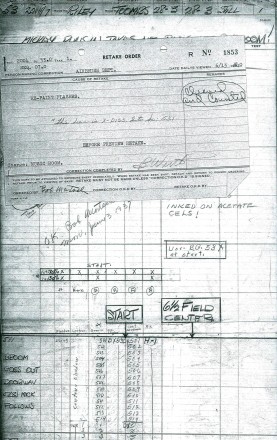
Here is a note attached to the first page of the
exposure sheets about a reshoot.
Animation &Animation Artifacts &Disney 28 Dec 2011 05:55 am
Mickey and the Brooms – part 5
- Here’s the final bit of character animation as Mickey comes out of the room having hacked the broom to splinters. He combines with some of the shadows that were posted last week.
All that’s left of the scene for me to post is the set of exposure sheets as well as some samples of the rendering for the airbrushing. Believe it or not, that’s my favorite part of the whole thing. Next week.
The scene was animated by Riley Thompson with Harvey Toombs assisting. The sequence director was James Algar.
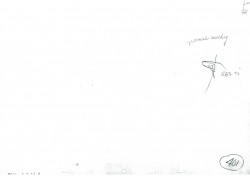
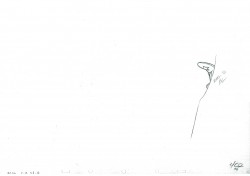 ____________________________
____________________________
The following QT incorporates all the drawings from this post
and the two earlier shadow posts.
All posts will be combined in the final piece.
All drawings were exposed per the Exposure Sheets.
this scene comes in at 5’30″
Animation &Animation Artifacts &Disney 21 Dec 2011 07:26 am
Mickey and the Shadows – 4
- We end the animation of the Shadows in this scene where Mickey conquers the undead, the brooms. The violent attack on the broom that he brought to life is done completely in shadows.
We have left Mickey walking out of the backroom and into the light. That will come next week.
The scene was animated by Riley Thompson with Harvey Toombs assisting. The sequence director was James Algar.
To see the last three parts of the shadows go to: Part 1, Part 2, Part 3
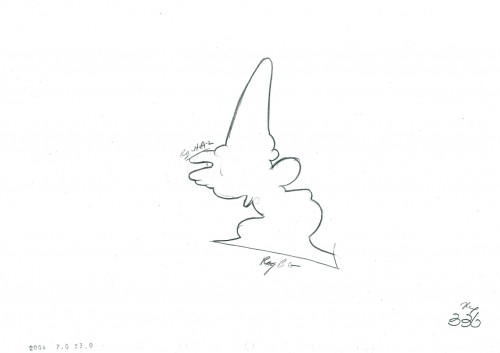 336
____________________________
336
____________________________
The following QT incorporates all the drawings from this post
and the two earlier shadow posts.
All posts will be combined in the final piece.
All drawings were exposed per the Exposure Sheets.
this scene comes in at 5’30″
Animation &Animation Artifacts 14 Dec 2011 07:03 am
Mickey and the Shadows – 3
Here is the next part of the violent shadows in the scene from The Sorcerer’s Apprentice. Mickey has to put a stop to the broom before it floods the Sorcerer’s workroom.
The scene was animated by Riley Thompson with Harvey Toombs assisting. The sequence director was James Algar.
To see the last two parts of the shadow go to: Part 1, Part 2
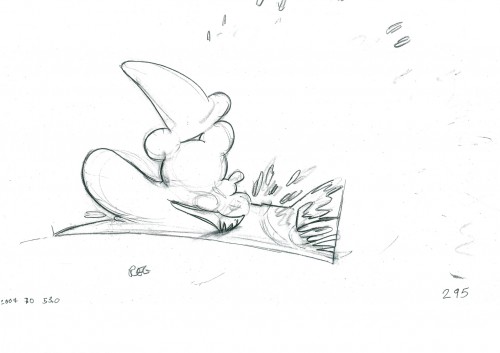 295
____________________________
295
____________________________
The following QT incorporates all the drawings from this post
and the two earlier shadow posts.
All posts will be combined in the final piece.
All drawings were exposed per the Exposure Sheets.
this scene comes in at 5’30″
Animation &Animation Artifacts &Disney 07 Dec 2011 07:21 am
Mickey and the Shadows – 2
- This is the fifth post of this scene, and the second that concentrates on the shadows. There are more where this comes from, and the post will continue with more parts. There are a lot of drawings to this scene (almost all on ones.)
However the scene’s a beauty. I think the animation by Riley Thomson recalls some of the earlier gutsy cartoon animation from the late Silly Symphonies. Mickey’s shadow moves several times from the right side to the left as he hacks away at the brooms. Whenever he walks, there’s always planned slippage in the movement. And the extremes are bold for a Disney cartoon. In a way, it brings Mickey back to his roots despite the high-minded subject matter of this film.
Harvey Toombs did the assisting. The sequence director was James Algar.
We start off this scene with the last drawing from the last post (Shadows Part 1):
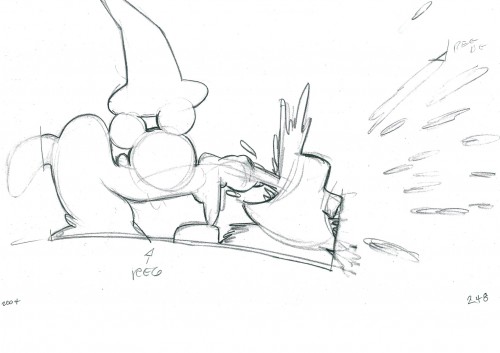 48
48
____________________________
The following QT incorporates all the drawings from this post and the last.
All previous posts will be combined in the final piece.
All drawings were exposed per the Exposure Sheets.
Animation Artifacts &Disney &Story & Storyboards 05 Dec 2011 07:18 am
Mr. Toad storyboard
- As every other animation blog out there will remind you, today is the anniversary of Walt Disney‘s birth. The difference between us and others is that this is also the anniversary of this blog. It’s the sixth year that we’ve been posting animation information, artifacts and ephemera on a daily basis. It’s been a real treat to continue doing so; I’ve learned a lot in the process and really do enjoy it. I wouldn’t mind going another six years.
- Hans Perk has just started posting the draft to the featurette, The Fabulous Mr. Toad, on his blog A Film LA. I can’t think of a better time to repost the original storyboard for the film. I’ve combined the several parts of the past posts into one longer piece.
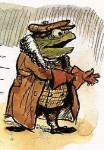 – Probably my favorite children’s book is The Wind In The Willows. There have been many animated adaptations of this book since it became a public domain item, but for years there was only one version, Disney’s Mr Toad half of The Adventures of Ichabod and Mr. Toad. The loudest most raucous parts of Kenneth Grahame’s delicate novel, blared their way onto this animated compilation feature.
– Probably my favorite children’s book is The Wind In The Willows. There have been many animated adaptations of this book since it became a public domain item, but for years there was only one version, Disney’s Mr Toad half of The Adventures of Ichabod and Mr. Toad. The loudest most raucous parts of Kenneth Grahame’s delicate novel, blared their way onto this animated compilation feature.
We all know that the book was planned as a feature way back when Disney, in the late 30s, was buying up titles of famous children’s books to prevent other competing studios from turning them into animated features. Work began on adapting the book. 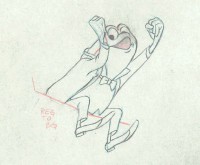 They never quite broke it as they hoped, and it ultimately became a featurette with its primary focus on the loose cannon, Mr. Toad.
They never quite broke it as they hoped, and it ultimately became a featurette with its primary focus on the loose cannon, Mr. Toad.
. . . .The film, as it exists now, has some positive elements and some fun animation, but the story was always a bit too quiet and British to successfully survive a proper adaptation in the Disney canon.
When John Canemaker loaned me his copy of the Pinocchio boards, he also brought The Wind In The Willows (not titled Mr. Toad). There are few captions here, but this obviously is designed for a full-out feature not an abbreviated featurette. The images on his original stats are small, so I’ve blown them up a bit and tried to marginally clean them up.
As suggested by Michael Barrier, this board was probably assembled to produce a preliminary Leika reel. The giveaway is the lack of dialogue and commentary underneath the drawings. The assembly was made to be photographed.
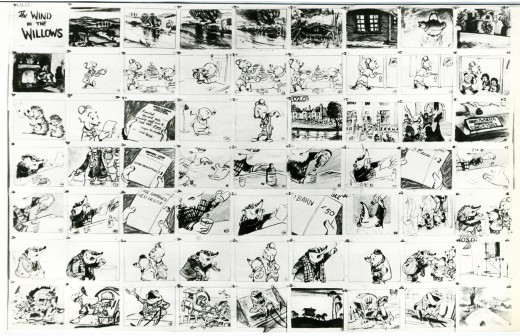 1
1(Click any image to enlarge.)
Disney’s Mr. Toad first aired on the Disneyland television program on February 2, 1955. You can buy the dvd of Ichabod and Mr. Toad on Amazon among other places.
If you’re interested you can read the entire book of Kenneth Grahame’s work (minus the beautiful Shepherd illustrations) here.
You can buy the book here.
Dave Unwin‘s version is my favorite adaptation in that it retains some of the flavor of the original book and isn’t afraid of being quiet at times.
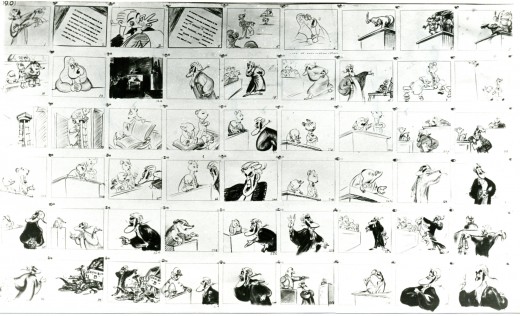 7
. .
7
. . 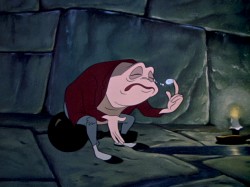
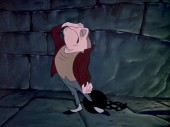
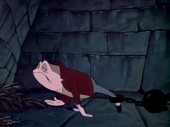
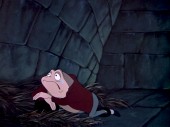 . .
. . 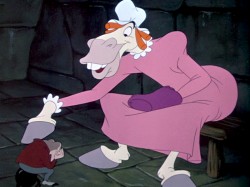
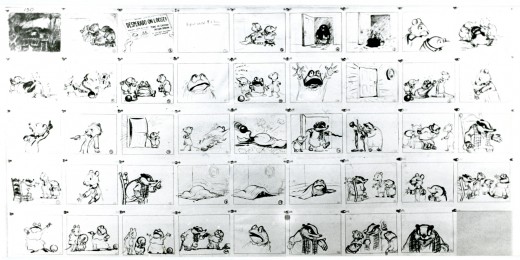 12
12
Action Analysis &Animation &Animation Artifacts &Disney 30 Nov 2011 06:36 am
Mickey and the Shadows – 1
- Having seen the entirety of Mickey chasing the broom into the adjoining room, we now take up the shadows that show us what Mickey does in there. Again there are many drawings (it’s all on ones) so this is the first part. (See past posts here.)
It’s animated by Riley Thompson with Harvey Toombs assisting. The sequence director was James Algar.
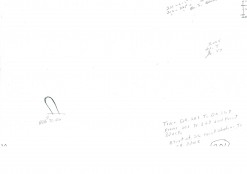 1
1 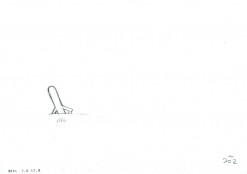 2
2
____________________________
The following QT incorporates all the drawings from this post
All previous posts will be combined in the final piece.
All drawings were exposed per the Exposure Sheets.
Animation Artifacts &Disney &John Canemaker &Peet &repeated posts &Story & Storyboards 28 Nov 2011 07:45 am
Ben and Me Board – repost
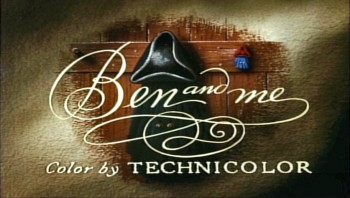 - Bill Peet was one of the prime artists who shaped many of the Disney features. He has been an enormous influence on me and thanks to John Canemaker, who has loaned me the following storyboard, I’m pleased to post some of Mr. Peet’s excellent artwork.
- Bill Peet was one of the prime artists who shaped many of the Disney features. He has been an enormous influence on me and thanks to John Canemaker, who has loaned me the following storyboard, I’m pleased to post some of Mr. Peet’s excellent artwork.
Ben and Me was a 20 min short produced in 1953. It’s an oddity in the Disney canon. The story of a mouse who influences Benjamin Franklin through many of his most famous moments was originally a book by Robert Lawson and was adapted by Bill Peet for the studio.
The photostats of the storyboard, like others I’ve posted, is extremely long. Hence, I’m posting them as large as I possibly can so that you’ll be able to read them once you’ve enlarged the images.
These three panels are followed by a couple more revisions. The revisions I only have as xeroxes – lesser quality.

This image is a recreation of the extraordinary pan as seen in the first row of the storyboard posted above. It’ll enlarge to a size where you can properly see it. A couple of the objects were on secondary overlays creating a minimal multiplane effect.
Bill Peet offered great drawings in his storyboards, and I’m sure he brought a lot of inspiration to the animators.

This is an excedingly long pan (30 inches), and is almost invisible in this minimal thumbnail. Rather than break it up into shorter bits, I’m posting it as is and hope it won’t be too much of a problem for you to follow in its enlarged state. You have to click on it to see it.
The image below is a recreation of this pan from the final film done using multiple frame grabs.
There’s an excellent article about the making of Ben and Me by Wade Sampson at Jim Hill Media. It gives quite a bit of information about this odd short and is well worth reading as a companion to these boards.
